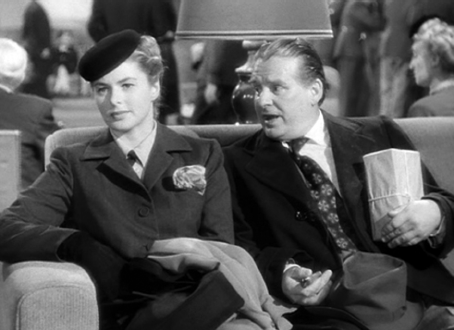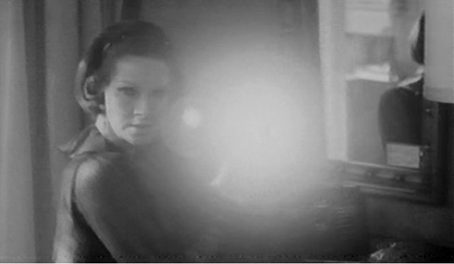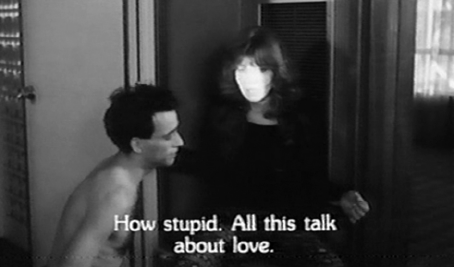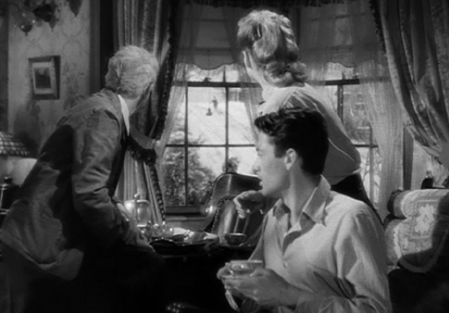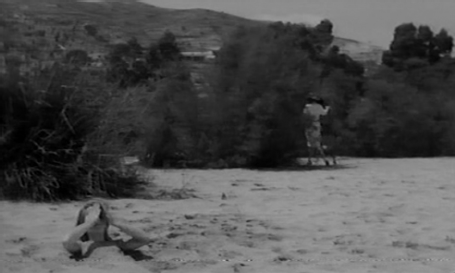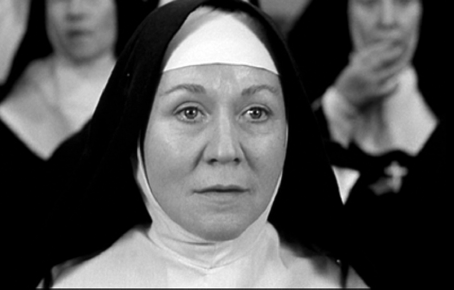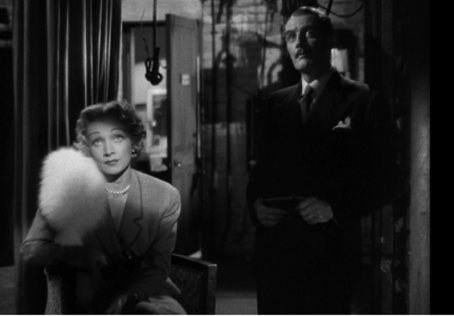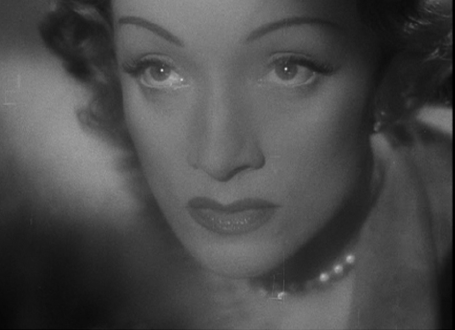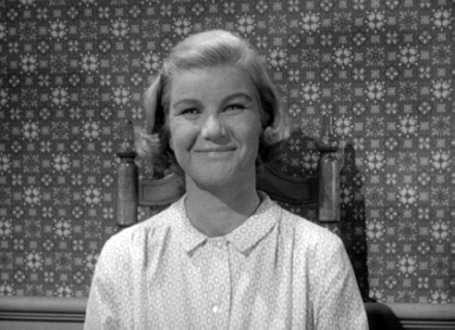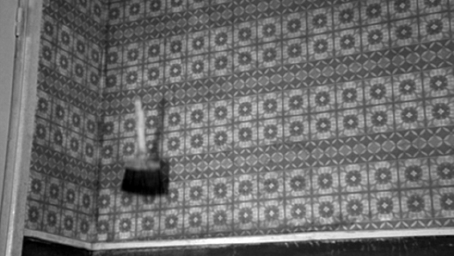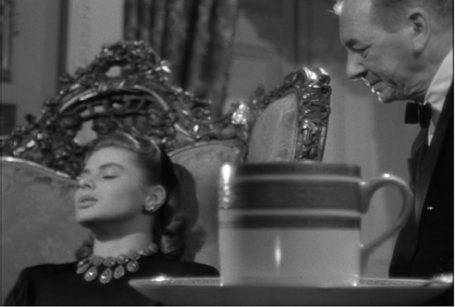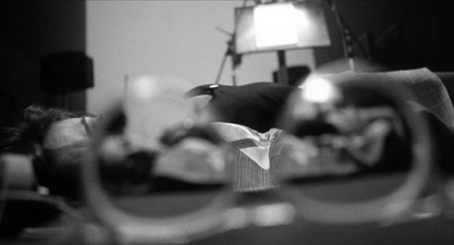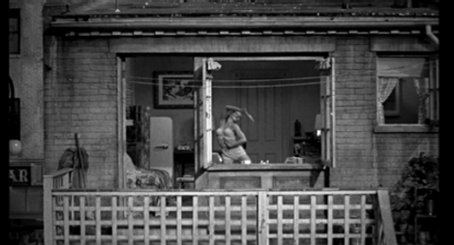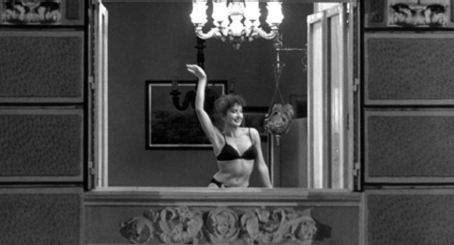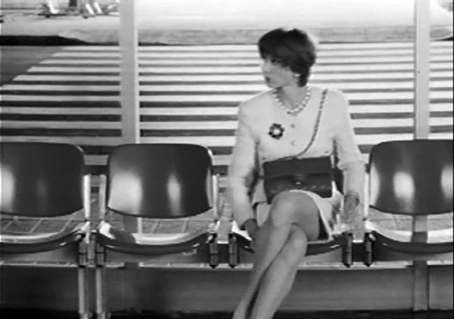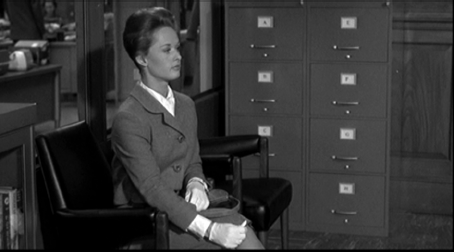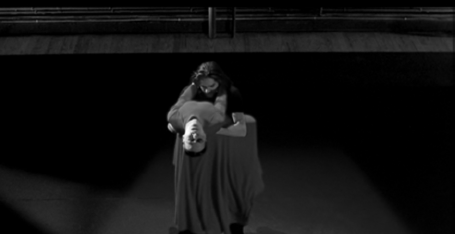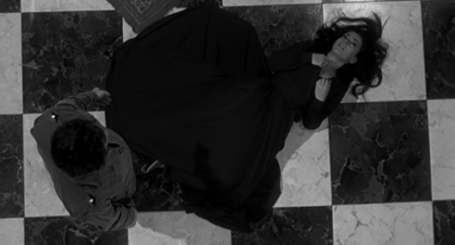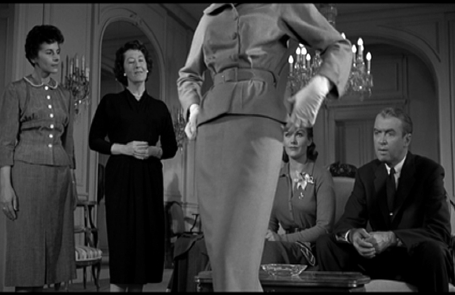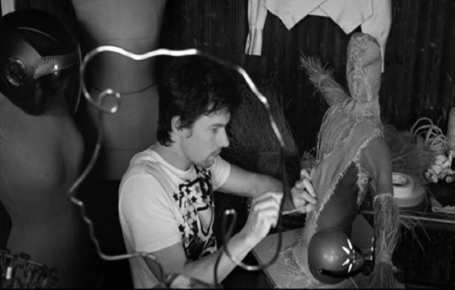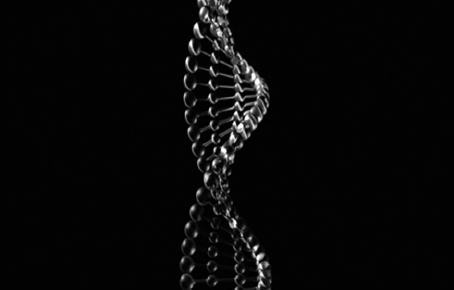I. INTRODUCTION: SELF-EDUCATION VIA HITCHCOCK
Much has been written about the impact of Hollywood classics on Pedro Almodóvar’s corpus of works.1 Almodóvar himself has responded to interview questions citing admiration for specific examples of ‘Golden Age’ Hollywood, to the extent that even he discusses choosing an aesthetic, ‘la más hollywoodiense de todas’ (‘the most Hollywood-like of all’), for Tacones Tejanos (High Heels, 1991) (Strauss 1995: 131). An extensive interview by Lynn Hirschberg in the New York Times Magazine, which appeared before the screening of La Mala educación (Bad Education) at the New York Film Festival, exemplifies the placing of Almodóvar in world film history. Hitchcock is not first on the list, nor the first name out of his mouth, yet Stephen Holden of the New York Times and many Spanish critics noted the presence of Hitchcock in Bad Education. V. A. Musetto’s observation in the NY Post – ‘From the Hitchcockian opening credits to the final frame, Almodóvar has Hitch on his mind’ – served as one of the major advertising blurbs for the film (New York Times, 11 December 2004). It is time, then, to look back at how signs of Hitchcock have been present throughout Almodóvar’s oeuvre, as we will see that Hitchcock was Almodóvar’s primary textbook and industrial model. Even after the global success of Mujeres al borde de un ataque de nervios (Women on the Verge of a Nervous Breakdown, 1988) established him as a major filmmaker, Almodóvar continued to study and learn from Hitchcock’s films.
It is important to remember that among contemporary Spanish directors Almodóvar is not a product of film school, or even of a fine arts education (as was Bigas Luna of the previous generation), but self-taught. He learned his craft experimenting with a Super-8 camera and watching movies. Hitchcock’s films have been easily accessible on subtitled videos in Spain for a long time, and his reputation as an innovator, among the first to incorporate sound in Blackmail and to experiment with it as a stylistic element in that very first sound film, makes his work an undeniable reference point for learning the craft of filmmaking. Moreover, Hitchcock is one of the few financially successful masters with a long career to study. In Alfred Hitchcock: A Life in Darkness and Light Patrick McGilligan attempts to redress a more monstrous view of Hitch put forward by Donald Spoto in his earlier Alfred Hitchcock: The Dark Side of Genius. McGilligan stresses Hitchcock’s success in the industry to reach this new balance concluding: ‘Hitchcock was not only the ultimate film director; he also mastered the pitfalls and politics of studio filmmaking that dogged him both in England and in America, and emerged as the industry’s consummate professional’ (2003: 747).
These factors argue for Hitchcock’s work being an essential reference point in Almodóvar’s autodidactic cinematic education. In fact the title of Frédéric Strauss’s collection of interviews, Almodóvar: Un cine visceral (Almodóvar: A visceral cinema), comes from Almodóvar’s comment on his eclecticism in his movies due to his self-education: ‘El ecleticismo en mis películas es algo como visceral que probablemente tiene que ver con el hecho de que yo no tengo una educación académica, no he aprendido cine en la escuela, lo que me da una especie de indisciplina y libertad’ (1995: 39); (‘Their eclectism is natural, instinctive. No doubt because I never had an adademic education, because I never went to film school, I’ve always remained undisciplined and free’) (Strauss 2006: 25).2 In the Strauss interviews Almodóvar mentions Hitchcock only cursorily when he discusses his early discovery of film classics. He cites Vertigo as the ‘mother of many movies’ in the session on ¿Qué he hecho yo para merecer esto! (What Have I Done to Deserve This?, 1984) (1995: 61). Yet Hitchcock’s name pops up at key moments of that text, from Laberinto de pasiones (Labyrinth of Passion, 1982) onwards. Almodóvar explains that when he came to Madrid he spent three years in the 1960s and early 1970s reading about film and screening films in the Filmoteca.3 During this period he first saw John Ford’s films, among other Hollywood classics, and Hitchcock’s work and criticism of it is well represented in the Spanish film archives.
When Strauss, addressing the attention to spatial design in Kika (1993), suggests that Hitchcock is one of Almodóvar’s favorite directors, Almodóvar’s reply gives a historical perspective to his reception of Hitchcock:
Yes. And I forgot to mention him! His work is visually the richest in the history of cinema. I discovered Hitchcock when he started shooting in colour. I was an adolescent at the time and simply considered him an entertaining director.4 […] Later, when I went back to see his films a second or third time, I started to understand the enormous genius operating behind each one of his images. Aesthetically, he’s one of the greatest innovators. All the visual elements in his work are artfully and deliberately thought out by the director. (Strauss 1995: 143, 160)
Just as Almodóvar corrects himself to recover his self-education through Hitchcock, we too will explore how Hitchcock’s aesthetics resurface throughout Almodóvar’s career. This is more than a passing relationship. What is most intriguing is how it appears to have been marginalised, or repressed.
II. ALMODÓVAR’S GUILT COMPLEX: FROM SPELLBOUND TO LABYRINTH OF PASSION
The impact of Hitchcock on Almodóvar is profound and far-reaching. Hitchcock is a reference point from Almodóvar’s earliest forays into film, in his cult movies depicting the Movida. When Strauss asks him to discuss the role of the psychoanalyst in Labyrinth of Passion, Almodóvar replies at length that Hitchcock’s flashbacks to childhood were his reference point for his own parody of psychoanalytic explanations. It is worth looking at this exchange between Strauss and Almodóvar in detail. Almodóvar’s self-construction via Strauss, his preferred chronicler, follows the interview model famously developed in the Truffaut-Hitchcock interviews. In bilingual sessions, Truffaut, who was Hitchcock’s professional equal, prompted Hitchcock to assess his career trajectory in terms of aesthetics, industrial strategies and world film history. For publication the interviews were organized chronologically according to the release date of the first film mentioned in the chapter. By following this model, Strauss, as a non-Spanish or ‘foreign’ expert, positions Almodóvar for transnational recognition as a serious artist just as Truffaut had for Hitchcock. Strauss prompts:
One of the funniest characters in Labyrinth of Passion is the psychoanalyst. She has nothing to say about the psychology of the characters she sees. She comes across as a purely comedic character. One feels you liked her for herself and not for one moment do you take her seriously. (2006: 25)
Almodóvar responds:
Yes, my use both of the character and psychoanalysis is strictly parodic. I wanted to do something which, in fact, I still haven’t dared do: to make a parody of all those films – Hitchcock’s included, which I like very much – where an elaborate flashback to the character’s childhood attempts to explain the inexplicable. The two main characters of Labyrinth of Passion often speak of their nymphomania and I decided that they should do so to a psychoanalyst in order to show that this type of behavior has no explanation. That’s my opinion, in any case. For certain scenes I used music by Béla Bartók very similar to Bernard Hermann’s scores for Hitchcock. The flashbacks to childhood are some of my favorite parts of the film. (Ibid.)
We know from Hitchcock’s own comments that he as well was none too fond of psychoanalysis (Peck’s character calls it ‘a lot of hooey’ in Spellbound), telling Truffaut that Spellbound was ‘another manhunt wrapped up in pseudo-psychoanalysis’ and that he also railed against superfluous explication in film, preferring to create character through a layering of details. So we cannot look at Almodóvar as an accurate film historian in this passage. However, what is evident here is his deference to Hitchcock in his own development as a filmmaker, and his choice of Bartók to evoke the classic Hitchcock score at a critical juncture of Labyrinth of Passion. This is a conflation of several Hitchcock references, for his most famous representation of a female psychoanalyst is Dr. Constance Sedgwick, played by Ingrid Bergman, in Spellbound, whose score is by Academy Award-winner Miklós Rózsa. Hermann did not come on board as a composer for Hitchcock until the 1950s with The Trouble with Harry. Almodóvar may refer to Hermann’s most famous score to Psycho or the thematic cueing of suspense in Rózsa’s score to Spellbound. Significantly, the primacy of music for childhood flashbacks reappears in Almodóvar’s films. Perhaps the strongest instance is the breathtaking ‘Moon River’ sequence in Bad Education.5 Certainly in 2004 Almodóvar no longer dares to present the childhood flashback as a parody anymore. From a wiser, more compassionate perspective, childhood traumas are too deeply felt to be subject to this treatment. However, the coupling of strong music with these sequences has its origin in Almodóvar’s appreciation of Hitchcock’s style.
Almodóvar is being rather devious in his mention of Hitchcock in regard to Labryrinth of Passion, for the Hitchcockian inspiration is profound, and not only in the psychoanalyst sequence. It is embedded in the picture’s title. In Spellbound, in the sixth sequence, late one evening, Dr. Sedgwick pulls a book from the asylum’s library shelves. Its title is shown in close up – Labyrinth of the Guilt Complex. She uses the book, ostensibly written by the new asylum director, being impersonated by the false Dr. Edwardes (Gregory Peck), as a subterfuge to visit him in his room. At that moment she does not know he is an imposter. The book’s autograph will be the key through which she finds him out.
The obnoxious Pittsburgh traveler tells Dr. Sedgwick (Ingrid Bergman) he knows she’s a wife trying to find her husband in order to make up in Spellbound.
Their dialogue, at first about the book, turns into a confession of love, which then is masterfully punctuated by shots of a long corridor of a series of doors being opened. These shots represent a subjective reality of the couple. The leitmotif of psychoanalysis – opening doors – began the movie’s intertitles. The more interesting analysis/interpretation in Spellbound is not retrospective then, but rather very present, in the passions of love, which is precisely Almodóvar’s take on Hitchcock. Spellbound is a ‘labyrinth of the passions’, especially Sedgwick’s passion for Ballantyne which overwhelms her ‘reason’ as psychoanalyst.
Further, in Labyrinth of Passion Almodóvar selects another important aspect of Hitchcock’s Spellbound to parody, namely the psychoanalyst in the movie itself. Hitchcock in fact engages in a similar bit of mocking humor in the sequence entitled ‘Pittsburgh in Manhattan’. Sedgwick is trying to track down Ballantyne who has fled to a Manhattan hotel because he was about to be unmasked as an imposter. When an obnoxious traveller from Pittsburgh approaches Sedgwick on the sofa of the hotel lobby, the house detective intervenes and throws him out. Both the Pittsburgh lout and the detective try to ‘read her’. The detective congratulates himself for identifying her as a schoolteacher following her husband to make up after a tiff. He calls himself a psychologist, but of course gets everything wrong. Sedgwick plays along, to the pleasure of the audience, and gets the information she wants, the number of Ballantyne’s hotel room. It is a classic Hitchcock moment, and a surprisingly feminist one as well, where the audience shares a joke with the female character. Indeed this sequence portrays a classic Hitchcock theme that domestic fiction not only passes as, but also is preferred to truth. Significantly Hitchcock’s cameo also takes place in this same sequence.
At first glance Almodóvar’s response to Strauss’ citing Hitchcock in the discussion of Labyrinth of Passion seemed out of place from my original recollection of the film which centered on Almodóvar’s ‘cameo’ – his crossdressing performance with call and response interaction that has given Labyrinth an extended life as a kind of Spanish version of The Rocky Horror Picture Show (1975) that emphasises audience participation in its kitsch world. Hitchcock’s films are not an obvious referent, even in parody. However the inspiration of Hitchcock’s films, especially of Spellbound, is pervasive in Labyrinth of Passion’s plot elements and leitmotifs. This does not detract from the recognition of Almodóvar’s originality, or an appreciation of the incredible cultural chasm between the US in the 1950s and Spain in the early 1980s. Almodóvar not only takes on a female psychoanalyst, Susana (Orfelia Angélica), to echo Bergman’s role, but he plays with Sedgwick’s’s most salient character trait in Spellbound, her initial frigidity. He inverts this by oversexing the female psychoanalyst, and further attributes the problematic Sedgwick frigidity to Sexilia’s (Cecilia Roth) father, a doctor who specialises in artificial insemination to compensate for his own lack of libido.
Spellbound abounds in father figures in all the doctors: one, the murder victim, Edwardes; two, the old head doctor of Green Manors, who turns out to be Edwardes’ murderer, whom critics have suggested was Hitchcock’s private representation of, and hence revenge on, his psychoanalysis-obsessed producer David O. Selznick; three, Sedgwick’s own first analyst, Dr. Bruhlo; and finally, the amnesiac John Ballantyne (Peck) whom Sedgwick first meets when he poses as Edwardes, the new head of the asylum. Hitchcock commented to Truffaut that he found Spellbound ‘very confusing’ (McGilligan 2003: 379). For Hitchcock, the guilt spread over Spellbound is of a dearth of testosterone that causes murder, even Ballantyne’s ‘accidental’ childhood killing of his brother. For Almodóvar, the problem is displaced primarily onto the female characters, especially Sexilia, who is doubled/impersonated by the cleaner’s daughter, just as Ballantyne doubled for Edwardes. Moreover, as Ballantyne cures Sedgwick of her lack of passion, so, too, the cleaner’s daughter cures Sexilia’s father of his. The similarities in plot are most interesting when seen combined with the repetition of motifs.
Sexilia seeks analysis due to photophobia; Ballantyne reveals his repressed guilt in trances provoked by whiteness. Labyrinth of Passion develops this parallel in the sequence in Tarfaya Salevi’s (Helga Liné) hotel room as it builds towards Sexilia’s flashback, the scene cited by the director in the above interview. In the dénouement Riza Niro (Imanol Arias) has just lost his virginity having sex with Tarfaya when Sexilia bursts into Riza’s room to see her. Sexilia slumps onto a stool against the wall at her realisation of the incest.
The film cuts to a medium shot of Tarfaya’s menacing face directing a mirror’s beam of light toward Sexilia as the reflection of light whites out the frame. A reaction shot shows Sexilia with the light beam on her face vowing never to love again. Violin music, similar to the thematic strains associated with Sedgwick and Ballantyne in Spellbound, accompany Sexilia’s next appearance, in a travelling shot as she runs to her psychoanalyst’s office.
Toraya’s mirror beam used as a weapon in Labyrinth of Passion.
Sexilia with the light beam on her face in Labyrinth of Passion.
Eventually Sexilia’s love for Riza will cure her of her photophobia, which is in turn a symptom of her nymphomania, just as Sedgwick’s love cures Ballantyne of his whiteness trauma and guilt complex. In one of the more famous scenes of Spellbound, Ballantyne goes catatonic over the white light off the tracks in the winter snow streaming in the window of Dr. Bruhlo’s office.
John Valentine (Gregory Peck) is transfixed by the blinding white light seen from the window in Spellbound.
In Labyrinth of Passion’s flashback, Sexilia lies buried in the sand, eyes covered, as Toraya and Riza move behind the bushes to make out.
Sedgwick has identified ‘white’ as a clue to his illnes; the couple head off to a ski resort to probe the repressed truth further. In Labyrinth of Passion Almodóvar inverts the northern light world into a southern coastal beach sun. At the psychoanalyst’s office, Susana opens the curtains so that strong sunlight falls on Sexilia who is seated against a white wall. The film flashes back to Sexilia’s childhood, where as a young girl she walks on a blindingly bright beach. Ballantyne’s brief childhood flashback reveals he killed his brother when he slid down a banister and pushed the brother into impaling himself on an iron fence. Sexilia’s flashback is longer in duration and more elaborate; in the flashback sequence Tarfaya pulls Riza away to make out with him behind the bushes as Sexilia remains buried in the sand up to her armpits with her hands covering her eyes.
In revenge Sexilia agrees to be ‘la mujer de todos’ (‘the woman/wife of everyone’) and in a game of house she engages with all the remaining adolescent boys. The young Sexilia is only shown with her bathing suit strap unfastened. Labryinth of Passion suggests but does not show adolescent sex, incestuous or otherwise, but this taboo gives force to the film. In a sense, following Hitchcock’s paradigm allows Almodóvar to find and define cultural boundaries.
In the film’s conclusion, Sexilia flees with Riza to Contadora Island in Panama, the place of exile of the real Shah of Iran in 1979. In retrospect the political context in Labyrinth of Passion of Islamic terrorists is prescient, especially given the early twenty-first century’s global preoccupation with Islamic militants. Likewise, at the moment of release of Women on the Verge, Candela’s problems with Shiites only sounded like some funny alliterative words uttered by a fruitcake personality, whereas after the Iraq War (2003–2011), Shiites and Sunnis are now commonly recognised distinct groups. There are very few movies, and even fewer comedies of this period, that make so many political references, and this for Almodóvar who was considered famously apolitical at the time. In integrating a political backdrop, but not making political films, he again follows Hitchcock. To recall, Hitchcock said, ‘Politics is bad box office anywhere’ (McGilligan 2003: 539). There are more minor details in common, such as the policeman in Labyrinth of Passion who draws glasses on a magazine cover of Riza when they are seeking him, just as the policeman in Spellbound draws glasses on a photo of Sedgwick when she is sought.
The final scene of Labyrinth of Passion strongly alludes to Hitchcock. He ends North by Northwest with a high-angle shot of a train whizzing into a tunnel; the protagonists’ voices are heard making love inside their train car. Hitchcock has said explicitly in interviews that the tunnel scene meant sexual intercourse (Truffaut 1984: 150). He was proud of skirting the censors with the tunnel scene, which is considered audacious for his time. Almodóvar ends Labyrinth of Passion with a prolonged take of an airplane rising, a clear phallic image. In voiceover Sexilia comments to Riza on their exceptional climax: ‘Darling, you’re the first man I’ve screwed in mid-air.’ For as explicit as Almodóvar is in depicting transgressive sex – gay, communal, and incestuous – throughout Labyrinth of Passion, it is curious that he returns to a heterosexual couple at the happy ending. The sequence acknowledges his Hitchcockian ‘guilt complex’; further, he embeds Hitchcock’s well-known ending in his own as if it were a purloined letter, or a book in plain sight that is the clue to the mystery in Spellbound.
III. CASTING AND CLOSE-UPS IN DARK HABITS AND STAGE FRIGHT
Entre tinieblas (Dark Habits, 1983) is the Almodóvar film most overtly concerned with Catholicism due to its setting in a convent. Yet it epitomises more secular, industrial preoccupations for it represents the first of several struggles for control with producers. As Almodóvar recounts to Strauss, Dark Habits was not only ‘a producer’s movie’ (Strauss 1995: 45), but one made, on spec, to showcase and woo Cristiana S. Pascual, the wife of his financial backer, Hervé Hachuel, after Pascual had threatened to leave him. Meeting Hachuel, he immediately understood the unwritten rule that Pascual, though only an aspiring actress, had to be the star of the script that Hachuel was shopping for.6 Almodóvar dutifully wrote Dark Habits as a star vehicle for Pascual, casting her as Yolanda, the actress who takes refuge in the convent.
The history of Hollywood is littered with stories of battles between directors and producers over casting and other elements of creative control. Few are more legendary, prolonged, or well documented than David O. Selznick’s dictatorship over Hitchcock.7 It is worthwhile to compare how Hitchcock handled casting, especially that imposed on him by his producer for Stage Fright (1950), and how Almodóvar dealt with a similar dilemma, or opportunity, for Dark Habits. Both films depict the world of the theatre. Most significantly, Marlene Dietrich was the source of inspiration for both films. In the conception of Stage Fright Selznick made it clear to Hitchcock, his director under contract, that he wanted the picture to star Jane Wyman, also under contract to Selznick. Stage Fright was already a star vehicle at this point, for it was written with Dietrich in mind. Coincidentally this caused numerous rewrites of the script’s ending because it was argued that a leading lady like Dietrich could be the prime murder suspect, but the audience would never accept her as the actual murderer. The solution was for her character’s lover to confess to the murder.
Stage Fright marks Hitchcock’s sole collaboration with Dietrich. Almodóvar said that Dietrich, especially the theatrical Dietrich of Der blaue Engel (The Blue Angel, 1930), was his prime reference for Pascual’s part when he wrote Dark Habits (Strauss 1995: 46). The problem for Hitchcock was not really Dietrich, for he handled her masterfully and convinced her to choose for one of her contract-mandated musical numbers ‘The Laziest Girl in Town’, a Cole Porter song that became her signature piece. Hitchcock’s more vexing problem was Wyman because he did not think her appropriate for the part of the ingénue who goes undercover as a maid/dresser to Dietrich. He insisted that the ingénue dress in a homely fashion for most of the film, which went against Wyman’s desire, to literally shine in her wardrobe. Wyman was a star in Selznick’s stable, but it was tough, if not impossible, for any other star to shine opposite the diva Dietrich. When Hitchcock gave in to Wyman and Selznick, and dressed her up in a glitzy garden party frock, the effect in Stage Fright was discordant. Hitchcock has Dietrich comment sarcastically on the transformation: ‘Whatever happened to that peculiar girl?’
In a sense Cristina Pascual was Almodóvar’s Wyman because Dark Habits had in its cast more established stars such as Julieta Serrano in the part of the Mother Superior. Almodóvar has said about his career: ‘Dark Habits is when I begin to realise what cinematographic language is’ (Strauss 1995: 48). Finally, his producer now provided him with enough resources with which to experiment. Furthermore, one of the most important steps in his learning process was to discover the force of the close-up, the use of which is generally considered the sine qua non of the contractual definition of a star. He discovered in Dark Habits that Serrano could hold a close-up, could express deep emotions via the shot, whereas Pascual’s role was not working out. In a sense, the veteran stage actress Serrano, like Dietrich from Wyman, stole not just a scene, but the whole movie from Pascual. The plot changed because of Almodóvar’s experimentation with close-ups. Significantly when Yolanda performs her raunchy stage number, Serrano steals the spotlight with her soulful close-up reaction shot that shows she has fallen in love with Yolanda.
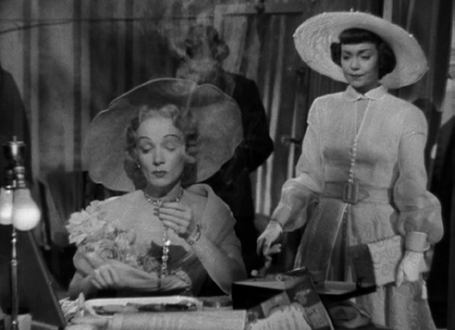
Dietrich and a pouting Wyman in the dressing room in Stage Fright.
Julieta Serrano in close-up, transfixed by love in Dark Habits.
The reaction is later magnified in Yolanda’s dressing room as Serrano, like a modern day St. Veronica, contemplates the cloth with Yolanda’s image on it from the removal of her make-up. In comparison, we can recall Hitchcock’s masterful lighting of Dietrich, as she always demanded, in Stage Fright especially in the climatic section when the detective is holding her in custody in the theatre. Charlotte (Dietrich) has just come under suspicion for the murder, but her demeanour shows her unperturbed. She is seated in a dark backstage area in front of a curtain facing the camera with a tall detective standing next to her. A beam of light falls over her. The mood is sombre.
Marlene Dietrich telling the detective her story of unrequited dog love in Stage Fright.
Extreme close-up of Marlene Dietrich closing a scene in Stage Fright.
She makes innocuous, but symbolic conversation to fill the time, telling the detective she once had a dog. When it did not love her, or respond to her absolute love, she had it killed. The spotlight and her intense facial expression communicate soulfulness, worldliness. No matter what, she is in control just as she controls her final close-up, which closes the scene.
Dietrich/Charlotte’s soulful domination, as she spins a tale of unrequited love, is similar to how the melancholy Serrano/Mother Superior controls the screen and eventually the narrative of Dark Habits, as Yolanda abandons her. Almodóvar calls the resolution to the love story ‘the most dramatic part of the story, which almost comes as a slap to the spectator because it is not a nice ending, but it is the most honest solution that occurs to me’ (Strauss 1995: 56).
Stage Fright is a movie of significant close-ups, not only of Dietrich. In the amended conclusion, which takes place ostensibly below stage, Charlotte’s lover takes Wyman captive and reveals that he, not Charlotte, indeed killed Charlotte’s husband. Both Wyman and the murderer are portrayed in extreme close-ups that show her distress and his madness. Wyman is effective here, in the true locale of the ‘stage fright’, the theatre, when she does not have to share the scene with Dietrich.
Looking at Almodóvar and Hitchcock together in this generally unexpected comparison shows a similar production history, a common blending of musical and theatrical numbers in balancing the films’ designated castings, and a masterful use of the close-up in both cases. It shows, moreover, how in both cases the need for close-ups altered the film’s narrative.
IV. THE DOMESTIC CRIME SCENE ENLIVENED BY WALLPAPER: ‘LAMB TO THE SLAUGHTER’ AND WHAT HAVE I DONE TO DESERVE THIS?
Many Spanish critics have long been highly critical of Almodóvar’s films. They criticise particularly what they see as the incoherence of his scripts.8 On the other hand, French and American critics have interpreted, and pardoned, the excesses, or incoherencies, within the generic parameters of melodrama.9 Frédéric Strauss, in the introduction to Pedro Almodóvar: un cine visceral, points to scriptwriting as both the definitive characteristic of the director’s work, as well as its primary defect: ‘Such meanderings are the weakness which make up the strength of Almodóvar’s films; incapable of giving his scripts a rigid structure, of curtailing his imagination, his limitless inventiveness, he allows each story, each character, major or minor, to live to the full; in other words, sometimes anarchically’ (Strauss 2006: xii).
However, interpreting Almodóvar via Hitchcock, and particularly through the lens of Hitchcock’s generic preferences, of individualistic strands of suspense and comedy, can give us a different, and perhaps better appreciation of Almodóvar’s development as a filmmaker as it brings other elements into focus that have not yet been looked at together. Looking at Almodóvar through Hitchcock foregrounds Almodóvar’s detective side, or the crime story, in the narrative structure of his films. This is true for What Have I Done to Deserve This?, Women on the Verge of a Nervious Breakdown, High Heels, Kika, Flor de mi secreto (Flower of My Secret, 1995), Carne trémula (Live Flesh, 1997), Todo sobre mi madre (All About My Mother, 1999), Hable con ella (Talk to Her, 2002), Bad Education, Volver (2006), Broken Embraces and La piel que habito (The Skin I Live In, 2011).10 What Have I Done to Deserve This?, Women on the Verge and Bad Education, which span his career, offer salient cases of this detective side or crime story. Almodóvar’s turn to the crime story coincides with what I am terming his commercial career – that is, the beginning of significant international distribution. This career really begins with What Have I Done to Deserve This? in 1984. This film was the first to receive distribution in France, three years after its Spanish release. Attention to Hitchcock in this film served as a bridge to commercial success on an international scale.
In What Have I Done to Deserve This? we find the first elaborate Hitchcockian structure to Almodóvar’s narratives. The film is basically a crime story, a detective story with a murder in it. The harried Gloria, who works as a cleaning lady, kills her cab-driver husband Antonio with a ham bone. The plot is in fact a rip-off of one of Hitchcock’s most well known TV stories from Alfred Hitchcock Presents, namely ‘Lamb to the Slaughter’, which Hitchcock directed in 1957. It starred Barbara Bel Geddes, who played Midge in Vertigo, and was made immediately following that masterpiece. Patrick McGilligan describes the episode: ‘“Lamb to the Slaughter,” based on a short story by Roald Dahl (who also wrote the teleplay), was about a devoted wife, spurned by her louse of a husband, who clubs him to death with a frozen leg of lamb. As detectives scour her house for clues to the crime, the lamb cooks delectably, ultimately becoming their supper’ (2003: 556). Almodóvar changed the meat course to ham; he also has the detectives accepting a cup of the broth from the incriminating stew rather than sitting down to a full meal. He waits until Women on the Verge of a Nervious Breakdown to invite detectives to sit down and partake of a suspicious potion made by a female lead, in this case the gazpacho with sleeping pills. In both ‘Lamb to the Slaughter’ and What Have I Done to Deserve This? the murderesses escape punishment, but are left isolated in their houses.
The final sequence of ‘Lamb to the Slaughter’ shows the detectives and their team feasting on the lamb/murder weapon at her dining table. The camera moves back to reveal the doorway and Bel Geddes in the other room. Then the film cuts to Bel Geddes who sits alone rigidly upright on a straight-backed chair against a wall of the living room. She absurdly maintains a conversation with the detectives from the other room that emphasises the sense of a purloined letter. When one detective comments while reaching for more meat that the murder weapon must still be ‘right under our very noses’, the film shows her wicked, but at the same time idiotic, smile.
Her expression tells the viewer she has gotten away with the murder. She is portrayed against large print graphic wallpaper, a decorative motif that dominates Almodóvar’s mise-en-scène throughout What Have I Done to Deserve This? as well. The reincorporation of the wallpaper shows Almodóvar’s attitude toward cinematic influences. Speaking on What Have I Done to Deserve This?, a film in which grandmother and grandson watch Splendor in the Grass (1961) at the cinema together, Almodóvar emphasised that any borrowing should not be reverential but rather undertake significant ‘active’ revisions that become markers of his own authorship:
Mrs. Maloney’s (Barbara Bel Geddes) smile in ‘Lamb to the Slaughter.’
The sorcerer’s brush on the wallpaper in What Have I Done to Deserve This?
Cinema is always present in my films, but I’m not the kind of cinephile director who quotes other directors. Certain films play an active part in my scripts. When I insert an extract from a film, it isn’t a homage but outright theft, and becomes an active presence rather than a homage, which is always something passive. (Strauss 2006: 45)
This call to action is taken literally in What Have I Done to Deserve This?. The wallpaper, which is a featured element of the mise-en-scène of Hitchcock’s teleplay from the scenario of the murder to the Cheshire smile of Mrs. Maloney at its end, assumes an even more prominent role in What Have I Done to Deserve This? such that it becomes Disney-inspired – ‘active’.
After Gloria has killed her husband, she hesitantly agrees to watch the psychic redheaded child Vanessa for Vanessa’s mother Juani, who despises her daughter. Symbolically turning over a new leaf, Gloria is about to repaper the kitchen. She finds out that Vanessa ‘has magical powers’ when the child repapers the kitchen telepathically. The wallpaper brush moves over the walls like Mickey’s mops when he plays the sorcerer’s apprentice in Disney’s Fantasia (1940). Gloria’s smile, shown against a backdrop of the vintage wallpaper, recreates Mrs. Maloney’s sense of satisfaction at the end of ‘Lamb to the Slaughter’. The viewer sympathises with the female leads through reaction shots, which symbolise their freedom in the domestic realm.
These magical special effects demonstrate Almodóvar’s desire to assert his own humorous tone and demonstrate mastery of the original cinematic material. The use of special effects, which are rare in Almodóvar’s films and Spanish cinema of the 1980s, underscores the claim to originality at the same time as it appeals to mass culture.
The representation of forgery in What Have I Done to Deserve This? serves to characterise the cab-driver husband Antonio. As he proudly hands his passenger a book of Hitler’s letters he has forged, he tells him of his love for a German singer he met while a Gastarbeiter. This scene characterises Antonio both as a Fascist sympathiser and as a two-timer, which gives him a similar profile to the policeman husband Patrick Maloney in ‘Lamb to the Slaughter’. Never taking off his policeman’s blue coat while he downs a whiskey neat, Patrick tells his wife bluntly that he is seeing another woman and wants a divorce. Through the forgery leitmotif Almodóvar silently acknowledges his debt to Hitchcock’s plot of ‘Lamb to the Slaughter’. It is one of a series of the staging of scenes of simulation that runs throughout Almodóvar’s work; yet the postmodernist interpretation also serves to reinforce the interpretation of the forgery leitmotif as an allusion to the stealing of Hitchcock’s plot of ‘Lamb to the Slaughter’ as the basis for What Have I Done to Deserve This?. Just as Antonio is proud of passing his talent for forgery to his son, Almodóvar proudly cites other classic American films to displace his ‘theft’.
This theft is further obscured by references to other plots. When the illiterate grandmother begs her son to compose a letter back to her village, she asks him to imitate Grace Kelly’s style; a glamour shot of Kelly is inserted. Grace Kelly, one of the classic Hitchcock blondes, became a star through her work with Hitchcock, beginning with Dial M for Murder (1954). In this film the husband (Ray Milland) tries to frame his wife Margot (Kelly) for a murder he himself staged. He incriminates her by planting one of her love letters in the coat of Swann, whom she kills when he attempts to strangle her. A head-shot poster of Paul Newman, star of one of Hitchcock’s later films Torn Curtain (1966), also appears on the wall of Gloria’s son’s bedroom. These allusions are meant to divert our attention from the primary ‘robbery’ of ‘Lamb to the Slaughter’ to a more general appreciation of cinematic history and Hitchcock’s place in it.
Both directors approached filming tragicomedy through similar techniques. Although Dark Habits included crane shots, which Almodóvar says in interviews give the angle of God, their use in What Have I Done to Deserve This? is even more effective and communicates a social commentary, as did a similar use of this shot in the blackmail sequence of Dial M for Murder. The debonair husband Tony Wendice strides back and forth in the apartment to demonstrate how the dishevelled, penurious Swann should enact the murder of Tony’s wife before paying him off.11 In What Have I Done to Deserve This? the high-angle shots – that transgress the possible boundaries of the claustrophobically small, familiar apartment – effectively convey the oppression of Gloria by her husband Antonio. An example of the use of the high-angle shot occurs in the ‘Bien paga’o’ (‘Well paid’) sequence in which Antonio forces Gloria to have sex in order to get bus money out of him to get to her job. The film intercuts and gives a musical soundtrack to the exploitation, with Almodóvar himself playing an officer in the zarzuela sequence of the song on the TV program, which the grandmother is watching in the other room. These transitions between sequences, whose effect is to thematically comment on Gloria and Antonio’s marriage, mark one of the most brilliant moments of the film.
Almodóvar found his narrative stride in What Have I Done to Deserve This? through the hybrid mix of the kind of melodramatic crime story that gave Hitchcock his renown.12 How profound is the forgery, or as Almodóvar prefers to call his reworking of other films, ‘the robbery’? Was the early scene of sex in the martial arts academy shower room an allusion to Hitchcock, in this case, Psycho? What is clear is that What Have I Done to Deserve This? ‘steals’ Hitchcock’s teleplay narrative, which is substantially reworked in the recurring motif of the ham bone/chicken leg/club/curling iron. All of these items are obvious phallic symbols, as was the leg of lamb Mrs. Maloney took out of the freezer, as were the ‘recurring motifs (including the phallic implications of certain household objects)’ (McGilligan 2003: 472) in Dial M for Murder. Their humourous effect is broad, domestically oriented, and analogous in Hitchcock and Almodóvar. The basic story of both What Have I Done to Deserve This? and ‘Lamb to the Slaughter’ is of revenge on the caveman.
Yet the ironic humour of situations remains part of the plot as the movie ends by coming full circle. Back on her job as a cleaning woman at the martial arts studio, and working out her frustrations with heavy chops of the weapon sticks there, she again encounters the policeman she had sex with in the film’s opening shower scene. When she confesses that she killed her husband with a ham bone, he rejects this story and waits for her to invent another version. He chooses to believe she is only distraught. Hitchcock played with similar narrative ironies often that tweaked our sense of the plausible, and reminded us playfully that we are watching cinema. The milkman in Foreign Correspondent (1940) would not accept that spies could pursue the dashing protagonist John Jones, who was pleading for help wearing a disguise. Jones had to quickly weave another fiction to get the milkman’s cooperation. The milkman was only ready to believe the story of a domestic affair – that is, that Jones was trying to avoid a jealous husband. Just like the detectives of ‘Lamb to the Slaughter’ the investigator in What Have I Done to Deserve This? overlooks the obvious, wilder possibilities, and underestimates the protagonists. In both Hitchcock and Almodóvar the rejection of the protagonists’ confessions shows that patriarchal society is not yet ready to accept the changed role of women.13 These films, however, position the viewer to recognise the process that set that change in motion.
V. LOOKING THROUGH OBJECTS AND ALMODÓVAR’S ‘MACGUFFIN’: FROM DIAL M FOR MURDER, STRANGERS ON A TRAIN, REAR WINDOW, AND THE THIRTY-NINE STEPS TO WOMEN ON THE VERGE OF A NERVOUS BREAKDOWN
We cannot underestimate both Almodóvar’s desire to make it as an international director and the effect that the two films that preceded Women on the Verge of a Nervous Breakdown in distribution – Matador (1986) and La ley del deseo (Law of Desire, 1987) – had on his reputation as a director. True or not, those two films pigeonholed him as a director for a gay audience, and even more crudely, as a director of kinky sex. Almodóvar was almost given a dare to make a PG-13 film for the sake of his career. Also, as Paul Julian Smith notes, by achieving foreign popularity he could make credible his claim within Spain ‘to represent post-Franco Spain to the outside world’ (1994: 102). Once again Hitchcock, who fought the censors valiantly over the years to put sex, double entendres and taboo subjects on screen, with abundant humour and enormous success, was the perfect model. Hitchcock managed to entertain without offending the public. While incest is suggested, infidelity abounds, the protagonist will have a baby out of wedlock and female orgasm is depicted, Almodóvar’s next film, Women on the Verge of a Nervous Breakdown, was received as ‘pure theatre’. Since clothes are kept on, film censors judged the film totally inoffensive. Almodóvar slyly winks at (his self-)censorship in one of the final sequences. As Pepa (Carmen Maura) walks by the fully-clothed Carlos (Antonio Banderas) and Candela (María Barranco) making out on her sofa, Pepa pulls a towel up over Candela’s cleavage. The towel is so small that the gesture only serves to mock facile rating standards.
While the story of Women on the Verge of a Nervous Breakdown speaks more to American screwball comedies – a genre Hitchcock only tried once, successfully, too, in Mr. and Mrs. Smith (1941) with Carole Lombard – both the overall balance in tone that melds comedy and drama/crime story, and especially the construction of certain shots and sequences that evokes ‘pure cinema’, show a deep appreciation of Hitchcock. Almodóvar planned the shots of Women on the Verge of a Nervous Breakdown in storyboards, which represented a change in his practice. Hitchcock was known for such careful storyboarding that the legend goes that he was bored when he came to the actual filming.
Although Cocteau’s short story La voix humaine (The Human Voice, 1930) served as the inspiration for the film, the key object of modern life at the centre of the film’s story – the telephone – sent Almodóvar thinking of Hitchcock again. In commenting to Frédéric Strauss on the importance of objects, particularly the answering machine, in Women on the Verge of a Nervous Breakdown, Almodóvar refers to Hitchcock’s special effect used to give an object prominence in the frame in relation to action in deep focus.
Object lesson: the giant tea-cup in Notorious.
Almodóvar gives the example of a cup. To recall, in Notorious, Alicia (Ingrid Bergman) is drugged with a spiked cup of tea, but the true, repressed referent here are the large telephones Hitchcock used for Dial M for Murder, for the filming and for the marketing. The giant phone later became part of the publicity campaign for the film, just as Almodóvar used a giant shoe for his opening night publicity parade for High Heels. Almodóvar explains his technical challenge in Women on the Verge of a Nervous Breakdown:
The machine in the film doesn’t really have the presence I wanted it to have. This made it difficult to compose shots where the machine was in the foreground and Pepa behind. When Hitchcock wanted a teacup in the foreground with characters in the back, he had a giant teacup made. You think it’s the lens which enlarges the object whereas in fact it’s a trick. (Strauss 2006: 81)
The most notable, famous sequence with a prominent telephone in Dial M for Murder occurs when Margot gets up in the middle of the night to answer a call from her husband who is plotting her murder. The shot is filmed from the supposed vantage point of the hired strangler, whom the viewer has seen hide behind the room’s curtains. Suspense and sympathy are built in the viewer as Margot crosses the living room, in her innocent and sexy white negligee backlit with the light from her bedroom, to answer the phone and is immediately attacked. Margot, however, withstands the onslaught and kills the intruder with her sewing scissors. The phone is a protagonist in the sequence as it both initiates the sequence of events and represents the husband on the other end of the line who has plotted the killing.
We should recall here as well that Almodóvar worked as an administrator at Telefónica, the Spanish national telephone company, during his early years of cinematic self-education. The Salón de Actos (auditorium) of Telefónica headquarters in Madrid also was the site for film screenings with actors and directors present. Even though Peter W. Evans in his BFI monograph on Women on the Verge of a Nervous Breakdown dismisses the importance to the film of Almodóvar’s telephone company years, as a ‘wish to take a parting shot at his former employers’ (1996: 13), Almodóvar’s attitude towards this experience has been more positive. He looks back on these years through the lens of a developing class consciousness: ‘I learned a great deal about the Spanish middle class which I could never have learned otherwise. This discovery is reflected in my films. Until then, all I knew about was the rural lower class’ (Strauss 1995: 21).
In 1996 Telefónica itself published a book Teléfonos de cine (Movie Telephones) by the critics Mariano Cebrián Herreros, Agustín García Matilla and Eduardo Rodríguez Merchán. The authors devote substantial attention to the films of Hitchcock and Almodóvar. They analyse the significance of the phone booth in The Birds, North by Northwest, Psycho, as well as in Dial M for Murder, comparing it especially to ¡Átame! (Tie Me Up, Tie Me Down, 1990) and Women on the Verge of a Nervous Breakdown. At very least this ‘industrially’ generated text, a luxurious volume, confirms a general, continued and important appreciation of Hitchcock’s work in Spain. It is worth looking at how the authors describe and interpret the sequence that Almodóvar referred to in the Strauss interview as his technical challenge, akin to Hitchcock’s:
The shot plan of the woman-machine encounter, the aberrant insert shots that give those machines this dualistic atmosphere, are underscored, if it could be even possibly more, by the Saturnian red of Pepa’s telephone. There exists a kind of dialectic or personal dialogue between Pepa and the answering machine; there is a moment of anthropormorphisation of the object. In fact, when the protagonist listens to the messages, she replies to the voice as if Fernando Guillén really were in front of her. There is an analogous scene that takes this relationship of dependence with the answering machine to its climax: in one of her trips home Almodóvar shows her with her eyes glued to the answering machine that appears foreshortened. As always, Pepa walks toward the table and the director moves the camera in until the machine appears in extreme close-up while she presses the button. But Almodóvar goes further: the answering machine, as if it were another character, looks back at the protagonist from its insides. A surprising subjective camera shot from the interior of the answering machine creates a disturbing image in which the orifices of the recording tapes align with Pepa’s bulging eyes. (1996: 55)
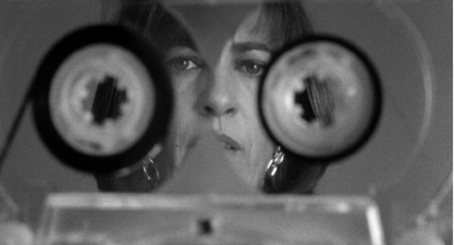
Pepa’s (Carmen Maura) eyes through the reels of the answering machine in Women on the Verge of a Nervous Breakdown.
It is particularly in this looking through objects where Almodóvar’s Women on the Verge of a Nervous Breakdown seems inspired by Hitchcock’s exceptional camerawork. The objects themselves represent a modern consciousness that distances and deceives in their superficial function to establish communication. Hence, not only is the telephone and its subsidiary apparati (the answering machine, the phone booth, the microphones connected to them) the leitmotif of the film, as seen in the shot of Pepa’s eyes, but looking at and through objects is its complex and transgressive modus operandi. The loudspeakers connected to the telephone being left on by the dubbing studio receptionist symbolise Women on the Verge of a Nervous Breakdown’s melodrama. All intimate details are broadcast to the public even as we look through the supposedly private space of the phone booth.
Besides the telephone sequence and leitmotif, there are other sequences of the film that allude to Hitchcock and carry through their common perspective of looking through objects and drawing attention to the cinematic apparatus as well. In an early sequence when Pepa is dubbing her voice for that of Joan Crawford in a scene from Johnny Guitar (1954) for which Ivan has already recorded the Sterling Hayden role, she faints and falls backwards. The final image is shot at floor level and shows her glasses in the foreground with Pepa in deep focus.
The fainted Pepa through her eyeglasses on the floor in Women on the Verge of a Nervous Breakdown.
This dramatic conclusion to the sequence alludes to Hitchcock’s stunning visual effects in the strangulation sequence in Strangers on a Train (1951). To recall, two strangers, Bruno and Guy, meet on a train. Bruno suggests exchanging murders. He will kill Guy’s wife; then Guy should kill Bruno’s father. Bruno lures Guy’s wife Miriam to a deserted island at a carnival. As Bruno strangles her, her glasses fall off and we see her falling down in the reflection of these glasses. Hitchcock used a giant concave mirror to achieve the floating shot of the fainting. He then double printed it on the image of a pair of giant glasses. Almodóvar stages his adaptation of Hitchcock as a rerun or dubbing of an old movie in a darkened room, like the carnival’s island at night.
In his article, ‘Melo-Thriller: Hitchcock, Genre and Nationalism in Pedro Almodóvar’s Women on the Verge of a Nervous Breakdown’, Enrique Acevedo-Muñoz states: ‘The shot of Pepa on the floor is a direct citation of Miriam’s death in Strangers on a Train’ (2006: 181). In comparing the respective sequences Acevedo-Muñoz makes two points: first, ‘formally, Almodóvar’s shot is different from Hitchcock’s since we see Pepa not reflected, but through the glasses, so it appears as mediation rather than a cinematic reflection’; and second, since the dubbing director, whom Acevedo-Muñoz considers a stand-in for Almodóvar, rescues Pepa, ‘the perversion of Bruno’s (and Hitchcock’s) action is here neutralized’ (ibid.). While Acevedo-Muñoz correctly appreciates the importance of the formal characteristics of this shot, when placed in the larger context of Almodóvar’s cinematic language of filming through objects, also seen in What Have I Done to Deserve This?, his interpretation of Hitchcock’s shot as ‘cinematic reflection’ is too literal and limiting. In the elaborate construction of the glasses shot Hitchcock ‘mediated’ the cinematic experience of the viewer as well. Although Pepa does not die as Marion did (although the carnival spectators when they find her body first yell ‘she’s fainted’), Pepa does have, in Acevedo-Muñoz’s words, ‘her first hysterical crisis over a Hitchockian moment’. To me Hitchcock’s ‘perversion’ – that is, the ability of cinema to affect the spectator – is very much exploited and left intact, rather than ‘neutralised’ in Almodóvar’s appropriation.
Almodóvar amplifies Hitchcock’s ‘perversion’, or focus on cinematic effects, when he integrates Rear Window into Women on the Verge of a Nervous Breakdown. When Pepa leaves her apartment at night for the street in her frantic search for Ivan, she stakes him out at his ex’s apartment building. She calmly sits down on bench across the street where she gazes at a varied tableau of actors and actions framed in the windows of the apartment building above her. The first point of view character Pepa the voyeur sees is a clear allusion to Rear Window’s Miss Torso, a buxom lady entertaining the viewer with her sexy dance to ‘Fancy Free’ in her underwear. In a second apartment she sees a young man crying into a handkerchief. The third window she trains her view on reveals the protagonist of the crime yet to be committed. Carlos, Ivan’s son, argues with his crazy mother Lucía (Julieta Serrano), who will later attempt to murder her ex.14
Miss Torso’s dance to ‘Fancy Free’ in Rear Window.
The sexy dancer that Pepa spies in the first window in Women on the Verge of a Nervous Breakdown.
Almodóvar stages ‘La ventana indiscreta’ – literally, ‘the indiscreet window’ as Rear Window is known in Spanish-speaking countries – with a Madrid location shoot, rather than with a single elaborate studio set, as Hitchcock famously did. Nothing is hidden in a back courtyard, but rather every character crosses the imaginary boundary of the private space of a dwelling, whose Beaux-Arts style is decidedly more opulent than Hitchcock’s Greenwich Village backyard set, to impinge on the public space of the street. With huge windows swung open to the night, Almodóvar’s ‘Miss Torso’ 1988 dances in the golden glow of a chandelier’s illumination. Significantly both the weeping man and the angry Lucía are not depicted within the confines of the window frames at all, but rather he poses on his sumptuous balcony as she paces on and off hers.
Hitchcock told Truffaut that Rear Window appealed to him for the technical challenge of ‘doing a purely cinematic film’ to show how the art of montage shapes a narrative (Truffaut 1984: 215). He gives the example of using the same reaction shot of Stewart smiling which could be read as ‘kindly’ if a little dog being lowered in a basket had been shown, or as ‘dirty’ if the film had cut from a ‘half-naked girl exercising’ (1984: 216). Likewise Almodóvar’s series of vignettes – exhibitionist, tearful and angry – always cut away for Pepa’s reactions, slight changes in facial expressions which we interpret as accepting, empathetic and upset because they are set up by the minimalist visual scenes which immediately proceed them. There is one exception to the alternating montage: the film cuts from Pepa to Marissa (Rossy de Palma), Carlos’s fiancée, sitting in a car waiting for him and peering at her via the rear-view mirror before it sweeps up to Lucía arguing with Iván above. Although in the subsequent confrontation with Pepa at the telephone booth Marissa expresses disapproval of ‘the slut’ who dances every night, her comment reaffirms that she did not turn away but watched the exhibitionist scene. In his more public mise-en-scène Almodóvar reaffirms and expands on Hitchcock’s point that ‘We’re all voyeurs to some extent, if only when we see an intimate film’ (Truffaut 1984: 216).
Although the dominant tone of Women on the Verge of a Nervous Breakdown is comic, moments of suspense, and not just in the climatic chase sequences, give the film its balance and drive. These changes in tone are signalled by a change in the soundtrack’s theme, and with cuts to low-angle shots of Pepa’s shoes pacing across her living room floor or on the stairs to and from her apartment. Hitchcock was notorious for shots of lower legs in motion. Both The Thirty-Nine Steps and Strangers on a Train, two of the most significant films of his British era, begin with low-angle shots of primarily men’s shoes walking. These shots characterise the well-heeled and convey a generic marker to establish a sense of action. Almodóvar achieves similar effects with these low-angle shots in a feminine register. They create tension for the crime story, mark Pepa’s social class and emphasise her active sexuality. Later Almodóvar repeats his generic marker when he ends High Heels with a shot through the basement apartment window of high heels passing by.
Of all of Almodóvar’s crime stories, Women on the Verge of a Nervous Breakdown is structured most like Hitchcock’s films because of its use of a MacGuffin. In Hitchcock’s films a MacGuffin is a storytelling device that motivates the plot, but which is in itself inconsequential. A prime example is the secret society called ‘The Thirty-Nine Steps’ which Mr. Memory elucidates at the conclusion of the eponymous film. In North by Northwest the MacGuffin, a Precolombian statue, or ‘pot’ as Roger Thornhill (Cary Grant) jokes, that contains microfilm, even evokes Hispanic culture. The use of a MacGuffin was often taken to indicate the apolitical nature of Hitchcock films because they were absurd or ‘deliberately beside the point’ by the time they were clarified (McGilligan 2003: 159). As McGillian writes in a section of his biography devoted to MacGuffins, ‘Although Hitchcock shied away from taking political stands himself, his circle was thoroughly socialist and antifascist, even including Communists like Montagu’ (2003: 158). In Women on the Verge of a Nervous Breakdown, Candela functions within the narrative as the bearer of the news of the MacGuffin. Almodóvar’s own mother, who reads a fake news broadcast describing a terrorist threat, further inscribes the film’s MacGuffin. The threat of Shiite terrorists kidnapping a flight to Stockholm sets up the final chase and dénouement of the film; it gives shape to the narrative like a Hitchcock spy picture. Yet in 1988 Shiite terrorism was not a great political force on the minds of most Spaniards.15 Although any inscription of terrorism within Spanish film of the time may perhaps be interpreted as a veiled reference to Basque terrorism, the absurdity and comic effect of Candela pronouncing ‘shiitas’ in her Andalusian accent argues more strongly for an apolitical stand.
Women on the Verge of a Nervous Breakdown alludes to more Hitchcock films than any other of Almodóvar’s films. Peter W. Evans, who notes the musical allusion to Psycho in the airport pursuit scene, the reference to Strangers on a Train in Pepa’s fainting fit, and Pepa’s voyeurist evening as evoking Rear Window, finds ‘these three direct allusions to Hitchcock in the film, all ultimately related to a shared interest in male anxieties about powerful women, and especially powerful mothers’ (2005: 15). Yet Evans misplaces the emphasis in his comments on Hitchcock. The mother role, especially that of Lucía’s mother, is of only minimal significance to Women on the Verge of a Nervous Breakdown, although the film indeed concerns ‘anxieties about powerful women’. Finally Dial M for Murder, the Hitchcock allusion that Evans overlooks, affords the best insights for a comparative interpretation. In that film Grace Kelly, like Carmen Maura in Women on the Verge of a Nervous Breakdown, is dressed in vibrant red as she entertains her American lover in front of her husband. Both women are threatening, but oh so attractive, in their liberated sexuality, both on and off the screen. The actresses, and their respective characters, ultimately prevail in these respective films, which are truly star vehicles. Finally it is not similarities in plot, or psychological stance as Evans has it, but the ‘pure cinema’ technique of the Dial M for Murder telephone shot which Women on the Verge of a Nervous Breakdown shares with Hitchcock’s films. Almodóvar looks through the representative objects of the middle class, connects with that class and triumphs at the box office with a high international standard of production values.
Hitchcockian tenets of filmmaking, such as storyboarding and the use of the MacGuffin, which Almodóvar newly employs in Women on the Verge of a Nervous Breakdown, helped him fashion his authorial brand. Like Hitchcock, Almodóvar understood the role of exceptional marketing in its creation. As Paul Julian Smith notes, the publicity campaign for Women on the Verge of a Nervous Breakdown in which Almodóvar posed in shots with the cast as had Hitchcock before him, was an ‘attempt to theatricalise the publicity on a much wider scale than had hitherto been attempted’ (1994: 102). To reinforce the connection between the two auteurs Juan Gatti, Almodóvar’s preferred publicity photographer, who began doing posters for Almodóvar’s films with Women on the Verge of a Nervous Breakdown, specifically mimicked Hitchcock’s iconic publicity shots in his series of portraits of Almodóvar that continue to be widely exhibited (see Almodóvar et al. 2006).
VI. BONDAGE BETWEEN NEW STARS: THE THIRTY-NINE STEPS AND TIE ME UP! TIE ME DOWN!
Women on the Verge of a Nervous Breakdown marked a definitive break between Almodóvar and his muse/actress Carmen Maura. They made a public display of their split by entering the Shrine Auditorium separately at the 1989 Academy Awards for which Women on the Verge of a Nervous Breakdown was nominated for Best Foreign Film, but did not win (see Basterra 1989). His next project had to feature a new female lead. Almodóvar speaks of the difficulty he had in retraining Victoria Abril to his method: ‘Victoria was ready to explode and scream, but she was also extremely modest and loath to express the simplest emotions both as an actress and as a woman’ (Strauss 2006: 93). While there are no quotes from Almodóvar indicating he thought of Hitchcock when he conceived of Tie Me Up! Tie Me Down! (1990), it is plausible that the well-known story of how Hitchcock used bondage to manipulate his actors in The Thirty-Nine Steps may have coloured his relationship with his new lead. It certainly resonated plotwise.16 According to McGilligan, in order to break down the ‘icy, forbidding’ (2003: 173) persona of the actress Madeleine Carroll, Hitchcock deliberately did not introduce her to her co-lead Robert Donat before the first day of shooting of The Thirty-Nine Steps. Then immediately after they shook hands, he handcuffed them together, did a few takes, then left them handcuffed together. McGilligan praises Hitchcock’s technique with actors: ‘Adopting an attitude toward his actors that the story took toward their characters: it was a Hitchcock strategy rarely expounded upon; perhaps it was subconscious, but it was effective’ (2003: 174). While Almodóvar did not emulate Hitchcock’s attitude to his actors, the anecdote highlights the sadistic actions of the character Ricki (Antonio Banderas) and recalls the blend of suspense and romance in The Thirty-Nine Steps. Like the fugitive Richard Hannay (Robert Donat) in that film, who bursts in on women in his flight, Ricki bursts in on Marina (Victoria Abril) in her apartment; the ensuing bondage is read as love by Ricki and sadism by Marina. This contradictory reading doubles the kitchen conversations between the crofter’s wife (Peggy Ashcroft) and Hannay in which a touching but dark kinship between her unhappy married state and his criminal profile emerges. Although the wife recognises him as a fugitive, she helps him escape again. In close-up we see her face as her husband begins to beat her upon discovering Hannay gone. This sequence doubles the overarching story.
In The Thirty-Nine Steps Hannay is pursued by foreign spies who think he has secret information. He bursts into the train compartment of Pamela (Madeleine Carroll) and kisses her to disguise his flight. Pamela later denounces him to the police, who refuse to believe Hannay’s story of foreign intrigue. The bad guys manage to kidnap Hannay and Pamela from the police station and handcuff the two together so they will not escape. They jump out of the car and wander across the countryside handcuffed until Pamela manages to squeeze her hand out while they are hiding as a married couple at an inn. Though physically liberated from her bonds, she falls progressively more in love with Hannay. The film ends with a close-up shot of their linked hands.
Like Tie Me Up! Tie Me Down!, The Thirty-Nine Steps is notable for its sensitive treatment of a woman in an unhappy marriage, and for its unconventional courtship, which features bondage. Many audiences objected to the almost sadistic actions of Ricki in Tie Me Up! Tie Me Down! Neither bondage nor forced sex was understood as metaphorically philosophising marriage, as Hitchcock’s handcuffs were in The Thirty-Nine Steps. Almodóvar bitterly recalls the film’s reception and defends this symbolic interpretation:
Tie Me Up! Tie Me Down! is almost a romantic fairy tale, but many people attacked it because they took it for precisely the kind of sadomasochist movie it isn’t. A lot of people went to see it in the States with pre-conceived ideas and expected God knows what. (Strauss 2006: 100)
Perhaps Almodóvar expected to repeat the reception of Hitchcock’s classic, also about marriage, which was embedded in the unconventional treatment of the topic of the film.
VII. LONG TAKES AND MULTIPLE CONFESSIONS: THE OTHER SHOE DROPS FROM MARNIE TO HIGH HEELS
When Almodóvar completed High Heels in 1991 he had a number of films in the pipeline at different stages. He was enjoying the financial security and independence of his own production company, away from studio pressures. Nonetheless High Heels takes the spectator into the realm of Hitchcock Hollywood, less for their shared star discourse, than for other aspects of their cinematic style and narrative constructs. As a constant source of inspiration, Hitchcock’s own self-imposed cinematic challenges, notably the long take, become Almodóvar’s own obsessions.
One well-known experiment of Hitchcock’s was the long take he planned for The Paradine Case (1947). According to McGilligan, ‘Keane (Gregory Peck) and Sir Simon Flaquer (Charles Coburn) walk toward the camera as they enter Lincoln’s Inn, part of the venerable fourteenth-century law complex. The two are seen entering the building, closing the door, walking up the stairs, turning the corner, heading along a landing into an office, and then continuing into the office, all in a single cut’ (2003: 395). Selznick, to whom Hitchcock was under contract, was dead set against the long take and deleted Hitchcock’s favorite effect from the film. Although The Paradine Case ‘was in the books as a permanent loser’ (2003: 396) – except in Mexico where it played well as Agonía de amor as we shall see in chapter five – Hitchcock persisted in his fascination with uninterrupted long takes at this stage in his career. Shortly thereafter when freed from his contract with Selznick, with his own production company Transatlantic Pictures, and now filming at the Warner Bros. studio, Hitchcock indeed realised his ambition and filmed his next project Rope (1948), based on Patrick Hamilton’s play Rope’s End, in sequential long takes of almost ten minutes in duration. The takes were so long he had to incorporate black shots of people’s backs when he had to change reels. According to McGilligan, this technique would ‘yield side benefits in both costs and publicity’ (2003: 400). Today critics consider Rope, the story of a murder planned for sport, one of Hitchcock’s most daring pictures not as much for his ‘gimmick’ of sequential long takes, as the scriptwriter Arthur Laurents calls it, as for how it represents the homosexual relationship at the core of its narrative, and how he escaped the censors to do it.17
Although it is not a sequence of motions as was the ill-fated take from The Paradine Case, in High Heels Almodóvar has Rebeca (Victoria Abril) describing Ingmar Bergman’s film, Autumn Sonata (1978), as a poignant analogy for the relationship between her mother and herself, in one long take set in an empty courtroom. Almodóvar recognised that this long take represented the film’s tipping point: ‘Before shooting it, I told Victoria the monologue could kill the film’ (Strauss 2006: 107). However, this closely coached sequence so held the technical crew in rapt fascination during its production performance that Almodóvar took the show on the road, so to speak, and had Abril perform the uninterrupted sequence at the film’s Paris opening to market the picture.
In his interviews Almodóvar does not specifically mention Hitchcock’s long takes in regard to High Heels. Obviously many long monologues are found in other master directors’ films, and certainly in Bergman’s. Rather, achieving a long take, and marketing it, was part of an industrial decision, and marked a certain stage in, and parallel between, Almodóvar and Hitchcock’s careers. Furthermore, as Almodóvar tells Strauss, he sees Hitchcock as the model for the multiple confessions of in High Heels’ narrative:
[Rebeca] confesses three times in the film and each time she’s truthful and sincere. The three confessions are complementary and give us an ambiguous impression. It was a huge risk, first of all because as a woman’s confession it had to be done in close-up. Watching an actress do a monologue confessing the same thing three times could have been rather boring. But Victoria managed to perform three different confessions, all very moving and different. From the start, this way of handling the story had the advantage of being less obvious, less classic and more difficult to achieve than the wrong man theme, having a false and a real killer. Hitchcock is the one who’s done it best. Throughout Rebeca is both guilty and falsely accused, but the difference is that she’s always accusing herself, which gives the impression of a superhuman control to the confession. (Strauss 1995: 118)
Which of the many confessions in Hitchcock films does Almodóvar refer to? To the confession of Mrs. Paradine (Alida Valli) on the witness stand? To Hitchcock’s first talkie Blackmail (1929) in which the protagonist Alice (Anny Ondra) tries to confess repeatedly to her beau Frank (John Longden), a Scotland Yard detective, that she murdered the painter Crewe (Cyril Ritchard) to thwart rape? After another suspect for the murder falls to his death in a chase, Blackmail ends with Alice attempting to confess at the police station. Her confession is thwarted by Frank. As the enamoured couple jauntily exit the station together, she is a free woman because of his protection. The situation of High Heels resembles Blackmail since in both films a representative of the law is sexually involved with a female who has committed homicide. In High Heels Judge Domínguez/Letal (Miguel Bosé) impregnates Rebeca and then tries to marry her. Or is the allusion to Rebecca, as signalled by the names of both mother and daughter in High Heels? In Rebecca information is progressively divulged; one of the most masterly revelations occurs in the extensive sequence in the boathouse where the husband Maxim deWinter (Laurence Olivier) confesses to his second wife (Joan Fontaine) his role in his first wife Rebecca’s death. The naming of the female protagonists Becky and Rebeca certainly directs us to Hitchcock.
Yet the strongest allusion is to the melodramatic mother/daughter tensions of Marnie (1964) for the two films share significant plot elements and leitmotifs. Marnie (Tippi Hedren), like Rebeca, feels rejected by her mother and is obsessed with recovering her mother’s love. In the final climatic sequence the mother, Bernice Edgar (Louise Latham), reveals to Marnie and her husband Mark Rutland (Sean Connery) the reason for distancing herself from her daughter. The mother falsely confessed to the murder of a sailor, one of Mrs. Edgar’s ‘johns’. But it was Marnie who actually killed the sailor because she believed the man was hurting her mother. Parts of the crucial scene are depicted in flashback.
Rebeca (Victoria Abril) tugs at the hem of her Chanel skirt while she waits for her mother to arrive at the airport in High Heels.
High Heels makes many subtle allusions to Marnie’s mise-en-scène from the beginning of the film onwards. Rebeca, who like Marnie, a master of disguise, is characterised by her 1960s wardrobe, wears a stunning white suit Chanel with a red purse. As she sits waiting for her mother’s arrival in the airport lounge, Rebeca squirms in the seat and tugs at the hem of the short skirt to pull it down. In the frontal shot the gesture emphasises her legs. What generally is a passing nod to good breeding and modesty is nonetheless the same gesture that Marnie makes when she waits to be interviewed by Mark Rutland for a job as his secretary in an early scene of the film.
In Marnie it is precisely Mark’s rememberance of having seen an attractive girl do the same skirt pull in the office of Mr. Strutt (Martin Gabel), a business client of Rutland’s, that leads Mark to hire Marnie in order to find out what makes her lie and steal, and not coincidentally, bed her in the process. Strutt, who never asked for references because he was blinded by Marnie’s charms, has just been robbed by the elusive secretary when Marnie comes to apply for the job at Rutland’s.
Marnie’s (Tippi Hedren) skirt tug hints at her identity as a thief in Marnie.
High Heels repeats the same fetishistic leitmotifs of purses and shoes found in Marnie. In both films their presence is exaggerated and a source of ironic humour. Marnie hides all her loot from safe robbing in her large handbags. The film repeats and ends with the children’s rhyme, ‘call for the doctor, call for the nurse, call for the lady with the alligator purse’. In High Heels Rebeca always carries a padded Chanel bag, contrasting with the colour of her suit, even to her mother’s deathbed. She takes the gun with which she killed her husband out of her purse and has her mother handle it. The fingerprints will bolster the mother’s false confession and save Rebeca. As to shoes in the two films, in a famous sequence from Marnie, celebrated for how it allows the viewer to participate in suspense and to know more than the characters, Marnie robs Mark’s safe after-hours. To avoid being heard by the cleaning lady, who is revealed as the camera pulls back to show both Marnie and the woman, Marnie takes off her high heels and puts them in the pockets of her coat. At a moment of tense silence in the soundtrack, we see in close-up insert shots how gradually one shoe slips out and clunks on the floor. However, the cleaning lady does not react nor turn around. The next sequence with a co-worker reveals that the cleaning lady is in fact deaf. Is it purely a coincidence that High Heels ends with Rebeca’s monologue about the sound of high heels representing her mother’s love for her? The quest for affirmation from her mother motivated Marnie to steal.
On the one hand, the kind of Hitchcockian confession Almodóvar elaborates on – ‘that Rebeca confessed to her crime from the very beginning but no one believed her’ (Strauss 1995: 118) – returns us to the many scenes of rejected or overlooked admissions in Hitchcock films, which we have already discussed, such as the milkman refusing to believe that Johnny Jones was being pursued by assassins in Foreign Correspondent, or even Mary Maloney’s smile of confession to her husband’s murder in ‘Lamb to the Slaughter’. On the other, it should also return us to consider that in High Heels’ confession Almodóvar claims to have improved on Hitchcock’s ‘wrong man’ theme whose epitome was I Confess (1951) about a priest wrongly accused of murder. The film closely respected Church rites in its language, had a theologian as a consultant, and received the full backing of the Catholic Church upon release. To this day it appears on the list of approved films of many religious groups, and even film scholars, such as Bill Krohn proclaim its ending, the final dying words – ‘Father forgive me’ – of Otto Keller (O. E. Hasse) the murderer to Father Logan (Montgomery Clift), ‘liturgically and thematically right (tranference of guilt healed by confession)’ (McGilligan 2003: 462). Precisely the presence of confession emphasises a kinship in the common Catholic backgrounds of Almodóvar and Hitchcock. Hitchcock in particular had fans in the priesthood, had his California vineyards farmed by seminarians, and was a major donor to Catholic charities. Not to be too virtuous about it, as McGilligan tells it, ‘Priests intrigued him; he found it amusing when the ones he met confessed their enjoyment for his sexiest, most violent films’ (2003: 440). Yet Hitchcock had a gruelling time trying to make I Confess, and the project was almost canceled several times. In the film, the priest is the Hitchcockian archetype of the wrong man – that is, he is falsely accused of murder. Yet he must respect the sanctity of the confessional and not reveal the true murderer who has confessed his sin. One controversial sticking point, which was expurged from the film, was that Hitchcock wanted the priest to have an illegitimate child. Moreover, the film was always conceived of as an anti-capital punishment manifesto. To give this poignancy, Hitchcock originally wanted the ‘wrong man’ priest to hang, but this gruesome ending was vetoed. Both politics and religion made the film a hot potato for Hollywood studios in the 1950s. So ironically, given the era’s conservatism, while Hitchcock was negotiating what he could or could not include in I Confess, he quickly made Strangers on a Train, with its ‘criss-cross’ murders and ‘criss-cross’ sexuality, with full and enthusiastic studio backing of Warner Bros. I Confess was a film that did notably better at the box office in Spain and in Europe than in the US.
Just as in Marnie, in which the last confession is that of the mother Bernice Edgars, likewise the last confession in High Heels is of the mother, Becky del Páramo (Marisa Paredes). Interestingly, Becky’s confession is a religious one conducted by a Catholic priest. The scene is a throwback to Hitchcock’s time and specifically to I Confess, for the priest acknowledges changes in the Church’s rites and asks Becky to confess using the words of her childhood with whose language she is more comfortable. In Spain of the 1990s the presence of a Catholic rite at the film’s conclusion, with realistic, doctrinally appropriate dialogue but a newfound humanistic intent – Becky finally only confesses, ‘I repent for unhappiness’ – reassured the audience. Overall it struck a balance in the film, particularly for an ascendant, increasingly Europeanised, middle class in Spain, which felt comfortable going out to Villarosa to see a female impersonator, or the movies to see both Miguel Bosé and Bibi Anderson impersonating the film star Sara Montiel, but still felt the need to invoke its Catholic heritage. Hitchcock found a similar balance, both socially and politically liberating while still rooted in tradition, for his worldwide audiences between his two contemporaneous films I Confess and Strangers on a Train.
High Heels can also be interpreted as an even more personal reconciliation, for Almodóvar has said that the final scene, reverential in tone, of Becky dying in her old apartment decorated in a Mexican style of her youth, recreates for him his own father’s death around 1983. The family helped his father, who was critically ill with cancer like Becky, return to his old village home, to the house of his father’s sister, to die in the bed in which he was born. Almodóvar’s description of his father’s final days is quite moving:
In my movies I never talk about fathers, but about mothers, like the one played by Marisa Paredes in High Heels, but that case is one of the few memories I have of my father. My father died of cancer about twelve years ago. My family was living in Extremadura. When he was in his last dying stages my father told my mother to take him to the village where he was born. He was gravely ill at that moment. So they returned to our village, where we were born, and since we no longer have a house there, they set him up in the house of his sister, which had been their parents’ house. It was the family home, where he had been born and lived. And then his sister had the good sense to put him in the same room where he had been born and in the same bed, in his grandmother’s room. He was in bad shape when he arrived, in great pain, and it’s incredible how death waited until he arrived at the place where he had begun his life. From the moment he arrived, he lasted about ten hours, his pains disappeared, and he died in the same bed where he was born. These memories are embedded in that part of Marisa’s life in High Heels, and curiously I’ve never spoken about that scene. It happens very fast in the movie, I don’t emphasise it, but it contains all that. (Strauss 1995: 68)
In this recounting of High Heels, Almodóvar reveals his own repressed emotions about his father’s death, and comes closer to a distant father, just as Marnie reconciled with her mother. Almodóvar returns to the theme of familial reconciliation in Volver.
It is not necessary to know about Almodóvar’s relationship to his father to interpret High Heels any more than it is necessary to know about Hitchcock’s alleged impotence or advances on Tippi Hedren, who played Marnie – some of the most contested elements of Hitchcock’s biography – in order to interpret Marnie. Yet these biographical details already participate forcefully in the cultural discourse. Almodóvar recites them, and judges himself in comparison to Hitchcock in these terms, while never divorcing his comments from an appreciation of what appears on screen:
Hitchcock used the scenes of his films as a way of approaching his actresses. Sometimes his difficult relationship with women enriched his female characters and inspired the most memorable scenes of his films, even if they also end up giving a rather negative image of the man. I don’t have such a complicated relationship with women; mine is much more generous and above board. Hitchcock’s talent was so enormous I’d prefer not to judge the man; probably in that regard he was a SOB. (Strauss 2006: 144)
The popular legends of these directors revolve around their respective representations of women in all their complexity.
VIII. DOMESTIC DETAILS AND THE REPRESENTATION OF RAPE AND SEXUAL VIOLENCE: KIKA, PSYCHO, TORN CURTAIN, REAR WINDOW, MARNIE AND FRENZY
Hitchcock has been a key referent for Almodóvar in constructing his scripts. Speaking of Kika, he says that its four chapters are each signalled by a change in music. The final chapter is cued by an intentional reference to Psycho:
This block begins when Rossy de Palma walks off alone in the street. I use the music Bernard Hermann composed for Psycho, music that will bind together the discovery of the hidden crime through an extract on the TV of Losey’s The Prowler, and Andrea’s entire nocturnal search through the videotape. Of all cinema composers, I consider Hermann to be the best manipulator of an audience. Even if only film buffs understand this, I allude through the music to another story of a man obsessed by his mother, just like Ramón is in Kika. It’s an amusing parallel. When Ramón enters the Casa Youkalli to speak to Nicholas, he seems unhinged. The house smells of a dead woman. Of course, the body of the woman played by Bibi is lying dead in the house. But Ramón believes he can smell the perfume of his mother whose suicide he never accepted. That’s where I use the theme of Kurt Weill’s ‘Youkalli’. (Strauss 2006: 113–4)
This is not the only time Almodóvar cites Hitchcock as inspiration for Kika’s effects. Discussing precisely the place in Kika of a domestic urge – to be ‘a practical woman’ – to manipulate the tone of the film, Almodóvar brings in his knowledge of the kitchen murder sequence of Torn Curtain, which is celebrated for its intensity and length, to bear on his idea for the prolonged rape of Kika. His comments are so germaine to our discussion that they deserve to be looked at in entirety.
In the film as it stands, Kika starts by resisting Paul, but the second he puts the knife to her throat she turns into a practical woman and tries to persuade him he has a lot of problems she can solve. This doesn’t indicate any pleasure on her part, because she’s passive; but it shows her enormous optimism. It demonstrates the strength women can call on in difficult, liminal, situations. For me it’s like the triumph of matriarchy. Two women, Kika and Juana, one violated and the other gagged, negotiate with the rapist in order to find a solution. I wanted to show this because it’s a feminine trait I admire a great deal. It’s also what makes the scene funny. If I’d written only the first half of the rape scene it would have stayed merely violent. Yet since Paul Brazzo is on top of Kika for hours, the situation has time to develop. The rape becomes irrelevant; a thirteen-stone man is on top of her and after a while she has the urge to put the house in order, to pee, to blow her nose. What’s important is that she’s immobilized in spite of having a lot to do and all kinds of domestic worries.
Humour always arises out of everyday life. Besides, you can only prolong any situation by playing it out naturally; that’s what makes things funny. In cinema, you normally use ellipses a lot, but if you dare to take a conventional situation that’s generally narrated in a brief time and make it longer instead, it ends up being surprising. For example, in Hitchcock’s Torn Curtain, there’s a moment in which someone kills someone else, but Hitchcock decides to show how difficult – how slow and exasperating – it is to kill somebody, and the crime becomes something entirely different. (Strauss 1995: 148–9)
Hitchcock repeatedly got the viewer’s attention with the humour of everyday life at critical moments in his films. For instance, in Rope as Rupert (Jimmy Stewart) leaves the party given by his former students, who are hiding the murder of a contemporary school chum, the maid hands him his hat which is bizarrely too small for his head. The plausible circumstance of getting the wrong hat at checkout is both a sight joke and a catalyst for Rupert to act as a detective, for he then deduces from the monogram that it is the murder victim’s hat left behind in the closet. What we see clearly in the above citation is that Almodóvar not only gets the humour of inserting elements of daily life into film, as did Hitchcock, but also he interprets Hitchcock’s work in a humourous direction when he cites Hitchcock’s film Torn Curtain in his own. Overall these are essential points in the reception of Hitchcock in Spain and Latin America.
The importance of using domestic details for comic effect in an intense situation is major strategy of Tie Me Up! Tie Me Down!, too. As Almodóvar notes:
I think it’s something many people have experienced: recognizing the sound of one’s partner arriving, saying ‘it’s me’ before you even see them. It’s always an emotional moment. The situation becomes comic in the film. Ricky announces his arrival so as to calm Marina when it’s precisely his arrival which terrifies her. He fixes the tap, he does the things any man would do for his girlfriend. These little things become much more significant within the situation the film describes. (Strauss 2006: 99)
The Strauss interview with Almodóvar on Kika turns more and more towards Hitchcock. It is as if in the artificial world of Kika that he sees himself as a mature director of Hitchcock’s stature. Strauss probes, ‘Were you thinking about Rear Window when you were making Kika?’, and Almodóvar aquiesces:
Yes, the backdrops in Kika have the same significance. They’re a painting that represents the city. Whenever one shoots in a studio, one’s main aesthetic reference is Hitchcock. This applies to everything and to every filmmaker. But I haven’t yet reached the extremes Hitchcock did in Marnie, where there’s an entire fake port with boats next to Tippi Hedren’s house. (Strauss 1995: 160)
Representing rape is always, and should always be, controversial. Neither Hitchcock nor Almodóvar shunned the challenge. Numerous Almodóvar’s films make rape integral to their respective narratives, especially Tie Me Up! Tie Me Down!, Kika, Talk to Her, Bad Education and The Skin I Live In. Hitchcock made resisting rape the motive for the homicide in Murder! (1930). Marnie posed a dual challenge to viewers and the censor board alike – whether the wedding night scene was to be interpreted as rape, and whether the repressed murder scene was to be interpreted as attempted child rape. Hitchcock fired Evan Hunter, his first scriptwriter on the project, because he questioned Hitchcock’s intention to portray the honeymoon cruise confrontation as rape.18 The second scriptwriter, Jay Presson Allen, followed Hitchcock’s bidding, and asserted in her script for the sequence that ‘fear and revulsion [are] manifest in her frozen face,’ as quoted in William Rothman’s Must We Kill the Thing We Love? (2014: 233). Rothman finds reason to suspend judgement over the ‘alleged rape’ in Marnie’s ‘frozen face’ reaction shot, which Rothman interprets as ‘a standoff between repulsion and attraction’ (ibid.). Frenzy, Hitchcock’s ‘last dark testament’ (McGilligan 2003: 714), contains the most lurid rape/strangling of all of his films through virtuoso montage. Hitchcock was considered ahead of his time in portraying a serial killer/sexual psychopath in Frenzy. Overall many of the murderous attacks on women in his films, so often committed with knives, from the British The Thirty-Nine Steps where the beautiful foreign spy gets a knife in her back and falls towards the protagonist’s bed, to the American Psycho, though here yielded by a ‘female-identified regressive’ (Smith 1994: 112), can be viewed metaphorically as rapes as well. On the other hand, Almodóvar has portrayed sexual violence against both men and women. He has said that the ritual killing by hairpin in Matador is a sexual reversal (I would add, of violence against women): ‘By contrast in Matador, Assumpta Serna has from the very beginning a very masculine role. She is the active partner in her relationships with men; she ends up penetrating and killing them with her hair pin, in a delibrate imitation of a torrero’ (Strauss 2006: 55).
Obliquely referring to the quandry of representing sexual violence on screen, Almodóvar has perhaps defensively termed Matador and Kika his most ‘abstract’ films. By this he means that they represent ideas, not characters or situations (Strauss 1995: 140). In the case of Kika, these ideas are moreover cinematographic concepts, as Almodóvar notes: ‘The day of Kika’s premiere I felt more vertigo than ever because I felt I was pushing the envelope. It’s a very personal work, full of purely cinematographic concepts, so I was afraid the audience wouldn’t understand it (Strauss 1995: 142). We could add his later films Talk to Her, Bad Education and The Skin I Live In to the list of ‘abstract’ films. Analogously Hitchcock’s ‘abstract’ films would be those of repressed memories: Murder!, Spellbound, Vertigo and Marnie.
The concept of voyeurism, which Kika probes in the foregrounding of the camera even in the costume design for Andrea Caracortada (Victoria Abril) and in the predominance of keyhole and iris shots, threads its way back to and through Rear Window. In Kika’s story, framed within the film until she casts off Ramón’s mother’s ring and takes off with the stranded motorist, she is positioned as a mother figure, and as the object of Ramón’s extreme scopophilic instinct. He insists on Polaroid photos of their sex, films Kika’s rape, and is imaged in the frame, head down, nose prominent, as Dalí’s ‘The Great Masturbator’ (1929). Almodóvar cites many of Hitchcock’s characters and situations. The chest that flies down on a rope/pulley from Nicolás’s upper-floor apartment, which we surmise contained the body of Susana (Bibi Anderson) whom he sadistically murdered, alludes to Rope. In that film the murder victim is placed in a chest kept in plain sight during a party. Ramón later discovers Susana’s body in the bathtub of Casa Youkalli with the shower curtain prominent in the frame, a location even more evocative of Hitchcock and Psycho. Most characters in Kika, such as the masochistic lesbian maid (Rossy de Palma), are stylised abstractions. In this the film radically differs from Hitchcock’s voyeurist masterpiece. Yet Kika takes as its point of departure the visual style of Hitchcock, and the psychoanalytical probing which his films suggest.
IX. TRAGIC LATIN FLOWERS AND A MOTHER’S VOICE: FLOWER OF MY SECRET, TOPAZ AND SHADOW OF A DOUBT
After Kika, whose mixed reviews made critics and the public wonder what happened to their beloved, but now stereotypical, classic Almodóvarian comedy, Almodóvar looked backward in his career and in terms of Hollywood genres with Flower of My Secret (1997). The film is an ode to classic women’s pictures, especially George Cukor’s Rich and Famous (1981), but also Billy Wilder’s The Apartment (1960), Casablanca (1942) and Singin’ in the Rain (1952), among other films. Given the Hollywood films cited, and the general effect of pastiche, Flower of My Secret is rather removed in genre and spirit from most Hitchcock films. Yet some motifs we have already discussed as characteristic of Hitchcock are present in what Marvin D’Lugo has called the film’s ‘international style with culturally-specific narrative elements that highlighted Spain’s gradual integration within a new European culture’ (1997: 117). As in many of Hitchcock’s works, the world of theatre frames the film and signals the artificiality of the filmic universe. Flower of My Secret brackets its story between an initial taped training session for doctors learning to present family members with the option of organ transplant, and the ending of a mother/son modern flamenco performance attended by the main characters. As in Torn Curtain’s climactic ballet performance, the lead dancers in Flower of My Secret, among them the amazing Joaquín Cortes as Blanca’s (Manuela Vargas) son, are also characters in the film’s main story. The final stage performance of Leo’s (Marisa Paredes) maid Blanca, dressed now in flowing blood red, a traditional flamenco colour, especially appropriate for the tragic love story told, emphasises the primary-coloured flowing and drape-like wardrobe of Leo throughout the film. The extreme overhead shot of Blanca and her swirling dress on stage as well as the climactic image of her backward fall recall the most celebrated shot of Hitchcock’s only truly Latin-themed film, the spy thriller Topaz (1969), set in the world of the Cuban missile crisis.
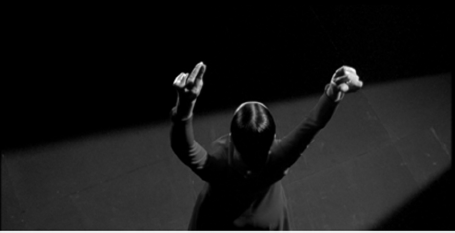
Overhead shot of Blanca’s (Manuela Vargas) extremely extended flamenco pose in a stage performance of a tragic love story in Flower of My Secret.
In Flower of My Secret Blanca falls backwards and drapes over the arms of Antonio (Joaquín Cortes) in a symbolic death.
Hitchcock’s tragic flower in Topaz: The dying Juanita de Córdoba (Karin Dor) falls backwards onto the patterned floor like a flower opening after Rico Parra (John Vernon) shoots her in the back during their embrace.
Like Flower of My Secret, Topaz’s story has plenty of the elements of a culebrón, or serialized soap opera, among them a marriage on the rocks with a strategic expert husband more interested in getting away to the site of the current world conflict, in Topaz, to Cuba, in Flower of My Secret, to Brussels or Bosnia, than in dealing with his wife. To recall, Topaz marked another of the moments in Hitchcock’s late career when he was trying to regain a former glory, this time, precisely after the disappointing showing of Torn Curtain. Almodóvar, perhaps following Hitchcock’s path, likewise turned to the topics of entertaining, escapist narrative to recapture his audience with Flower of My Secret. In Topaz when the Cuban military official Rico Parra (John Vernon) discovers that Juanita de Córdoba (Karin Dor), his former lover and a widow of a revolutionary hero, a character inspired by Fidel’s sister Juanita, is a double agent, he pulls her to his chest and proceeds to shoot her in the back, supposedly to save her from being tortured by others. An extreme overhead shot shows the dark Latin beauty Juanita lying on the floor, her long vibrant blue/purple dress pooled around her symbolising the blood flowing out of her. Hitchcock described the shot to interviewers as a flower opening:
I had attached to her gown five strands of thread held by five men off-camera. At the moment she collapses, the men pulled up the threads and her robe splayed out like a flower that was opening up. That was for contrast. Although it was a death scene, I wanted it to look very beautiful. (McGilligan 2003: 689)
Almodóvar has said he discovered Hitchcock when he was beginning to work with colour (Strauss 2006: 143). Flower of My Secret may in fact be Almodóvar’s secret tribute to Topaz’s Latin palette, cinematography and general flower motif. In Topaz one of the American operatives in New York, a Caribbean black, such an unusual ethnic presence for Hitchcock’s films, even runs a flower shop, where the spies exchange information in the cooler among the blooms.
Almodóvar worked on location for most of the interiors of Flower of My Secret. Doing so inspired his shots and distanced him from Hitchcock’s preferred modus operandi, especially when dealing with romance. If we briefly compare Hitchcock’s kisses to one of the most famous sequences of Flower of My Secret, the kiss between Leo and her husband Paco (Imanol Arias) in the vestibule of their apartment, in this shot the mirrored door fragments the images of husband and wife, foreshadowing their break-up. In a kiss in Hitchcock’s films, such as the many kisses in Notorious, which so irritate the Mexican critic Francisco Sánchez Aguilar he calls them ‘anti-cinematographic’ (2004: 210), or even one depicting an unstable relationship, for instance in Marnie, at some point the camera, not the décor, is intrusive. One part of the sequence will always be in extreme close-up. However, another signature Hitchcock close-up is parodied in Flower of My Secret, the scream motif placed on a transitional cut. Examples in Hitchcock are the cut from the train’s whistle to the woman’s scream upon discovering Annabella Smith’s (Lucie Mannheim) body in The Thirty-Nine Steps, and the cut to the shower scream in Psycho. Flower of My Secret cuts from the bedraggled Leo in her bathtub/shower, trying to shake off her suicide attempt, to an absurd ‘Concurso de gritos’, or scream contest, on the Spanish state-run television network. Moving from the more intimate contact of Leo’s mother’s voice, Almodóvar riffs on Hitchcock’s ‘internationalist’ technique to recentre the film nationally on an old stand-by since Franco’s time, the folkloric shows of RTVE.
Besides a certain visual bravado and theatricality, Flower of My Secret also repeats the domestic humour, which is a hallmark of Hitchcock, in the scenes with Chus Lampreave, who plays the part of Leo’s mother. Almodóvar has said in his interview with Strauss that numerous segments of the dialogue in Flower of My Secret are inspired by the words and habits of his mother – the reciting of a poem about the pueblo, the remembrance of his birth, the discussion of an eye operation as splitting open a melon, and the citing of the proverb ‘estar como vaca sin cencerro’, literally ‘to be like a cow without a bell’, that is, to be disoriented or to not know what to do with oneself. Flower of My Secret is the companion piece to the allusion to the father in High Heels in its nostalgic, personal tribute to his mother’s world, even though she does not personally act in this film. Starting with her stilted reading of the TV news in Women on the Verge of a Nervous Breakdown, Almodóvar’s mother appeared in several of Almodóvar’s pictures before her death. Her presence, and often that of her other son Agustín as well, became almost like Hitchcock cameos.19 Moreover, it should be recalled that it is Leo’s mother’s voice on her answering machine that brings Leo back from her suicidal stupor. Donald Spoto theorises that Hitchcock affectionately portrayed his own mother Emma, when she was close to her death, as the mother of the young Charlie (Teresa Wright) in Shadow of a Doubt (1942). Within the context of that picture she is the anchor of the smalltown values that are under threat. Overall Hitchcock’s portrayal of Emma (Patricia Collinge) is much softer, and less frenetic than Leo’s mother’s in Flower of My Secret. For instance, her husband and daughter praise Emma for selflessly working all the time. Nonetheless, the two films both single out one common trait of their respective mothers for comic relief – their telephone behaviour. In Flower of My Secret mother/daughter (Chus Lampreave and Rossy de Palma), yell and fight over one telephone to get their side of the story to Leo. In an early sequence of Shadow of a Doubt, Emma’s husband and children make fun of her for shouting into the telephone as she tries to take down a telegraph message. According to Spoto, it was a characteristic ‘amusing behavior’ of Emma Hitchcock (quoted in McGilligan 2003: 321). While noting the coincidence of the name Emma, and the scene in which Uncle Charlie (Joseph Cotten) presents the mother with a gift of paired portraits of their grandparents, Hitchcock’s daughter, Pat Hitchcock O’Connell, in Beyond Doubt, the documentary accompanying the 2000 DVD rerelease of Shadow of a Doubt, categorically states that the character of Emma was ‘nothing like her grandmother’.
X. SO MANY FEMMES FATALES: LIVE FLESH SPLICED BETWEEN BUÑUEL AND HITCHCOCK
Both Kika and Carne trémula (Live Flesh, 1997) were based on a mystery novel titled Live Flesh (1986) by the British writer Ruth Rendell. Kika treated material from the first chapter, and Live Flesh adapted the rest of Rendell’s book. Among Almodóvar’s works Live Flesh is distinctive for its noir genre and consistent tone.20 After complaining of numerous narrative and stylistic deficiencies he finds in Live Flesh, Carlos F. Heredero in a review in Dirigido goes on to praise the film’s ‘notable step forward’ due to its ‘expressive coherence which allows one to excuse even some defects in character development or certain concessions in the reasons for their behaviour’ (1997: 23). Despite the genre, ‘passionate drama with touches of thriller’ (1997: 22), the film recalls Hitchcock very little, if only in that the embedded film, Buñuel’s Ensayo de un crimen (The Criminal Life of Archibaldo de la Cruz, 1955), which plays on the television during the early crime scene in Live Flesh, itself pays homage to Hitchcock’s suspense films. Buñuel mocks psychoanalytical interpretation in Ensayo de un crimen precisely through his citation of two key motifs from Hitchcock films: the glass of milk from Suspicion (1941) and the razor from Spellbound. In Suspicion the poisoned glass of milk glows – a famous special effect – as the husband Johnnie (Cary Grant) carries it up the stairs to his rich wife Lina (Joan Fontaine). The glass of milk makes a reprise appearance in a pivotal sequence of Spellbound, often viewed as Hitchcock’s debunking of psychoanalysis. In Spellbound while shaving, John Ballantyne (Gregory Peck) regresses and in his trance, holding his open razor, threatens Alex (Michael Chekhov), Constance’s (Ingrid Bergman) psychoanalyst and master teacher, whose help in curing John through psychoanalysis he and Constance have come to seek. Alex gives John a glass of milk. The sequence finishes with a shot through the bottom of the glass as an image of milk, part of the film’s white leitmotif, fills the screen. At that moment the viewer suspects that John kills the doctor with his razor, but it turns out that instead the doctor has drugged John with the milk. It is a clear case of Oedipal confrontation. In Ensayo de un crimen the protagonist obsessively drinks only milk, a fixation upon his childhood and his mother, when everyone else has cocktails. There are insert shots of his glass of milk. However, neither milk nor razors are in the sequences from Ensayo de un crimen that Almodóvar selects for Live Flesh. Both Spellbound, in the impersonation of Dr. Edwardes by John Ballantyne, and Ensayo de un crimen, especially in the fabrication of a mannequin of the model Patricia, deal with doubling at the core of their problematics. The meltdown of the wax mannequin, Buñuel’s most famous shot in Ensayo de un crimen, because the effect was technically challenging and so expensive it could only be filmed once, is one of the signature sequences Almodóvar chooses for Live Flesh.
It is worth further exploring the nature of the doubles in these three directors’ respective films. The femme fatale in Live Flesh, reprising Angela Molina’s role from Buñuel’s Cet obscur objet du désir (That Obscure Object of Desire, 1977), is, however, a dark Carmen, not a Hitchcock blonde, on the order of the doomed Madeleine/Judy/Kim Novak of Vertigo.21 The sole (postmodern) blonde in Live Flesh, the Italian Elena (Francesca Neri) first appears in a frizzy blonde wig in her father’s apartment, where the camera pans over huge paintings of erotic art, in particular Titian’s ‘Venus and the Organ Player’.22 The contemplation of art in this sequence distantly recalls Vertigo. There Hitchcock’s stylised eroticism and doubling is set in motion as Madeleine studies the portrait of her ancestor Carlotta in the early art museum scene.
As Marvin D’Lugo observes, ‘Buñuel’s film-within-Almodóvar’s film emphasizes that Live Flesh is essentially a narrative about looking back and fits into the broader patterns of Spanish national cultural recovery though cinema and narrative of the 1990s’ (2006: 97). Like Dark Habits, and later Bad Education, Almodóvar through Buñuel characterises the times and especially the protagonist Victor through irreverent placement of Catholic imagery. For instance, Victor holds a photograph of Elena’s First Communion as he talks about having lost his virginity with her. The photograph almost protects him as she trains a gun on him to make him leave. Later Victor will often cite the Bible, which he studied along with Bulgarian in prison.
Live Flesh contains typical thriller or intrigue genre shots, such as the scream reaction shot of Elena, placed on a cut between sequences, as she hears the gun shots as Clara (Angela Molina) and Sancho (José Sancho) die in a murder/suicide in the film’s dénouement. The cinematic style of Hitchcock is sutured into Live Flesh as is Buñuel’s.
XI. DIVAS DON’T DRIVE: VEHICLE SHOTS, SUBJECTIVE CAMERA-WORK AND ORCHESTRAL SCORES IN ALL ABOUT MY MOTHER
I met Almodóvar in March 2002 at a talk he was giving at the Círculo de Bellas Artes (Fine Arts Circle) in Madrid. This event was one in a series of directors speaking on cars in the movies. He was still bathing in the spotlight of having won the Best Foreign Film Academy Award, but was obviously processing, decompressing from his Hollywood triumph with his compatriots who saw his triumph as their own. Almodóvar was in top form entertaining, and genuinely relating to, the young, overwhelmingly Spanish audience. He spoke not only of the glitter of Hollywood, but humbly about his own shortcomings speaking English, which left many in the crowd nodding in agreement. He appreciated the irony of his participation in the series on cars because as he pointed out, he does not drive, though he owns a car. He told a funny story of hopping into the backseat of a stranger’s car in his neighborhood that looked similar to his own, to the astonishment of the driver. The anecdote reminded the audience that divas do not drive, they are driven. Hitchcock never drove. He liked to be driven onto all sets to within steps of his director’s chair. In All About My Mother, Manuela (Cecilia Roth) has an opportunity to get close to Huma Rojo (Marisa Paredes) one night after a performance when Huma gets stranded at the theatre because her lover Nina (Candela Pena) has left in a huff. The diva makes a point of saying she never learned to drive.
All About My Mother is generically nothing like a Hitchcock film. The story does recall at times the diva film, Stage Fright, discussed previously in regard to Dark Habits. In All About My Mother, Manuela, then later Agrado (Antonia San Juan), serve as personal assistants to the diva Huma Rojo in her dressing room. In Stage Fright Eve Gill (Jane Wyman) takes over the part from Charlotte’s (Marlene Dietrich) real maid to serve as a dresser to Charlotte. In both films the female protagonist goes undercover. Eve Gill, a reporter, is searching for clues to a murder. Manuela, a nurse, is searching for rebirth, of herself and her dead son Esteban (Eloy Azorín), by going back to find Lola (Toni Cantó), Esteban’s transvestite father. Yet to go much beyond these analogies not only forces the comparison, but shows how the representation of sex and gender has evolved since the 1950s. As with Flower of My Secret, the film whose transplant sequence inspired Almodóvar to continue the story with All About My Mother, the allusions are more generally to classic Hollywood, and especially All About Eve (1950). As with Live Flesh and Buñuel’s Ensayo de un crimen, Hitchcock, whose Stage Fright with its perky Eve Gill preceeded All About Eve, is sutured into the film’s narrative along with Joseph L. Mankiewicz’s Academy Award-winning film.
As we have seen with other Almodóvar films, we can explore the continued emphasis on theatricality, and citations of famous Hitchcock shots, precisely from Hitchcock’s Concha de Plata (Silver Shell) films of the late 1950s, namely the tunnel shot of North by Northwest, or the use of subjective camerawork, a prevalent technique in Vertigo. As discussed before, the closing tunnel shot of North by Northwest is considered a metaphor for sex. Almodóvar recalls Hitchcock’s symbolism, but makes it his own in the tunnel motif of All About My Mother. After her son’s death, Manuela travels from Madrid to Barcelona by high-speed train. At each stage in her mourning process, the tunnel leitmotif signifies re-birth, going back to relive the birth of Esteban by seeking Lola. Towards the end of the film when Manuela takes Rosa and Lola’s baby Esteban with her to Madrid by train, the tunnel is first filmed from inside, from Manuela’s point of view. Since Manuela now has a new adoptive son, the tunnel suggests a birth canal. The film then cuts to an overhead shot of trains going through two tunnels, stating it is two years later, as Manuela returns to Barcelona with the child Esteban, where she will attend the father’s funeral, and find closure to her grieving for the first Esteban.
The first tunnel sequence, a subjective shot zooming into the tunnel, recalls the famous Hitchcock zoom techniques of Vertigo, which emphasise Scotty’s mental distress. Subjective camerawork, resembling that shot, also structures the early sequence when a car hits Esteban. As often in Hitchcock’s car sequences, for example as discussed and shown in Hitchcock’s storyboards in the DVD documentary on the car sequence of Family Plot (1976), Hitchcock anchors the sequence with shots from inside the car. In All About My Mother we see Esteban’s body break the windshield. The sequence here ends with even more powerful subjective camerawork. As in The Wrong Man jail cell shot of Manny (Henry Fonda), the camera moves erratically, in a random, yet circular motion, stressing Manuela’s panic, and showing her point of view as she finds Esteban’s body under the car.
Still, there are some other important parallels between Hitchcock and Almodóvar, in choices for the soundtrack, which are different than those already discussed and mark a change or break in All About My Mother with Almodóvar’s previous films. Furthermore, these choices reaffirm the role of Hitchcock’s soundtracks in his successful career formula. For Almodóvar, they represent a change in tone, which Almodóvar self-characterises as a mature voice (DVD interview, All About My Mother). Before All About My Mother, and after that film as well, the soundtracks of Almodóvar’s films are distinguished by their vocal music. Music, and especially what we could call his songbook, played a huge role in Almodóvar’s career to this point and after. As Kathleen Vernon points out, he became a ‘cultural entrepreneur’ in the global musical marketplace (2013: 386). Plaintive Latin American music, especially boleros – of Lola Beltrán, La Lupe, Trio Los Panchos, Chavela Vargas – sing the melodramatic messages of his films. The songs are so integral to the narrative that they must be subtitled for international distribution. Almodóvar has said, moreover, that he is rerighting a global injustice of Spain vis-à-vis Latin America with his popularisation of these classics songs:
Spain is very unjust with other Spanish-speaking countries. It feels a sort of superiority far from solidarity. There was a lot of hypocrisy in the celebration of the quincentenary of the Discovery of America. I discover things in a sentimental way. It’s gratifying to see how that works later on in the marketplace, because I think that it’s reestablishing justice. (Strauss 1995: 126)
All About My Mother veers away from the vocal and asserts an internationalist tone with its primarily orchestral score, recorded by the City of Prague Symphony. Like Hitchcock, Almodóvar has worked with several different composers throughout his career: Bernardo Bonezzi for most of his early career in international distribution, from What Have I Done to Deserve This? to Women on the Verge of a Nervous Breakdown, then unhapppily (because Almodóvar felt the product was not original) with Ennio Morricone for Tie Me Up! Tie Me Down! and disappointingly with Ryuichi Sakamoto for High Heels. Almodóvar scrapped most of Sakamoto’s score and substituted several vocals as well as existing instrumentals by Miles Davis and George Fenton. Almodóvar began to work with Alberto Iglesias on Flower of My Secret and Live Flesh, but really didn’t give him full reign – that is, he did not move away from the presentation of the film through his incorporation of vocal music, until All About My Mother.23
Ironically a full orchestral score, even with its harmonica parts, is less intrusive, more subliminal, than the vocally dominant scores. As Jack Sullivan observes in Hitchcock’s Music particularly referring to the recognition scene of Vertigo: ‘A product of the silent era, Hitchcock distrusted words but came to trust music; it spoke a language deeper than dialogue, allowing the world of obsession and longing, his favorite subject to have its say’ (2006: xix). This type of subliminal effect, through which the orchestral score seemlessly reinforces the melodrama, is perhaps best appreciated, and symbolised in its interplay, in one of the final sequences of All About My Mother when Manuela shows Esteban number three to Lola – Esteban number one – in a Barcelona café. The soundtrack features precisely a muted trumpet and the sequence dissolves out with a cropped image of the photograph of the lips of the dead son, Esteban number two. It is as if the Estebans were playing the trumpet.
XII. ATTRACTIVE CRIMINALS AND INVERSE SEQUENCING IN TALK TO HER
Both All About My Mother and Talk to Her begin and end in the theatre. Hitchcock pioneered this narrative structure in his early sound film The Thirty-Nine Steps, yet there are significant differences in the theatre pieces presented. In The Thirty-Nine Steps the spectacle is a variety show, most specifically the interactive segment with Mr. Memory, in which the audience calls out questions for him to recall the answers. The Mr. Memory segment is punctuated by some oddball questions although it has an overall serious undercurrent. In later Hitchcock the theatre of high culture, via orchestral scenes, frames The Man Who Knows Too Much (1956) from the initial close-up clash of cymbals to the climatic scene at the Royal Albert Hall. Almodóvar’s theatre spectacles are decidedly high culture – Tennessee Williams’ play A Streetcar Named Desire in All About My Mother, and Pina Bausch’s modern ballet in Talk to Her. Nonetheless, the way the main characters are introduced in shots outward from the proscenium, as well as where the characters are seated in the theatre, is common to both Hitchcock and Almodóvar.
One prominent technique of Hitchcock’s cinematic style – which he developed in his earliest silent films, consistently used throughout his career, and for which he is well known – was to begin a sequence with a close-up, and to pull the camera back gradually through the shots of the sequence to end the sequence revealing the full mise-en scène, in what conventionally would have been the view of an establishing shot. This sequencing was as often edited through cuts rather than in a continuous long take dolly shot. In a Hitchcock film this ‘inverse’ sequencing creates suspense and interest. Almodóvar uses a similar ‘inverse’ sequencing prominently and masterfully early in Talk to Her to introduce Benigno’s (Javier Cámara) role as the nurse of Alicia (Leonor Watling) who is in a coma.
The sequence begins with an extreme close-up of Benigno’s hands massaging Alicia’s muscles. The inverse sequencing hides, or prevents the spectator from immediately identifying, both the gender of Benigno and the location where the massage is taking place. Withholding this information until the final shot of the sequence, which encompasses the room from the point of view of the end of Alicia’s hospital bed, grants the information, or the surplus thereof, added importance. It brings a bit of a gasp to the viewer when she finally sees the male nurse Benigno and wonders if his soft physical appearance means he is gay, or if the erotically-charged massage of the beautiful Alicia that she first saw means he is heterosexual.
The comic dialogue between Dr. Roncero (Helio Pedregal), Alicia’s father, a psychiatrist, and Benigno regarding the latter’s sexual identification is both typically Almodóvarian and very much in the spirit of Hitchcock’s comic relief in narrative as well, as already discussed in respect to Foreign Correspondent and Spellbound. We know the characters are fabricating stories, and then question the cultural beliefs that make infidelity, and homosexuality, both more plausible and more culturally acceptable.
Talk to Her, like What Have I Done to Deserve This?, is a crime story. It tells the story of Alicia’s awakening from a coma through her sexual awakening, the prince’s kiss of Sleeping Beauty, or in the eyes of current law, through her sexual violation. The actual representation of the penetration, through the inserted silent film, also restages significant comic sequences in Kika. The sympathetic yet compulsive talker Kika awakens the supposedly dead Ramón sexually in an early sequence by putting make-up on him, and in one of the concluding sequences by putting his phallic big toe in a light socket. In Talk to Her Benigno takes advantage of his patient in a coma and is summarily condemned to prison for it. One of the greatest difficulties to being a fan of Almodóvar, particularly for feminists, female or male, is that he often makes some criminals attractive characters. Moreover, their criminal actions, which our cultural norms sanction, are made not only palatable, but also seductively admirable in his films. This quandary became most prominent with Tie Me Up! Tie Me Down!24 Although Antonio Banderas carried over his undeniably seductive screen persona from Law of Desire to Tie Me Up! Tie Me Down!, his actions as Ricky in the latter film were criminal, as he lorded over a prolonged kidnapping of Marina Osorio (Victoria Abril). Gloria (Carmen Maura) was a murderer in What Have I Done to Deserve This?, but her oppressive milieu made the viewer sympathetically consider the crime close to domestic abuse. Tie Me Up! Tie Me Down! afforded no such rationalising escape.
The very existence of so many criminal tales in Almodóvar’s opus argues at its most basic level for a strong appreciation of Hitchcock by Almodóvar. Yet how do Almodóvar’s ‘criminals’ compare to Hitchcock’s? The supplementary materials to the 2004 re-release of Hitchcock’s Warner Bros. films note the common bond between Hitchcock and Patricia Highsmith, upon whose first book Hitchcock based Strangers on a Train. To recall, this film, one of Hitchcock’s most highly praised, tells the story of Bruno (Robert Walker) and Guy (Farley Granger) who meet on a train. Bruno hatches the plan to crisscross murders to hide the motives for the crimes. Bruno then commits the first crime, murdering Guy’s wife, and hounds Guy to follow through and murder Bruno’s father in return. For Highsmith, the criminal was a Nietzchean Übermensch. Moreover, the reader was able to work through existential angst by relating to his plight. Likewise for Hitchcock, his Bruno was undeniably intelligent in launching the plot of Strangers on a Train. In Hitchcock’s own favourite of his films, Shadow of a Doubt, the dapper but menacing Uncle Charlie (Joseph Cotton), perpetrator of the Merry Widow murders, is finally never absolutely condemned, but instead understood in his worldview in the final sequence between the young Charlie (Teresa Wright) and the detective (MacDonald Carey). Significantly, that sequence takes place on the margins, in the church vestible at Uncle Charlie’s funeral. Yet more than clever, which the criminals of Highsmith, Hitchcock and Almodóvar are (to kill with a ham bone, for example, and then to make soup with it), these criminals appeal to the viewer. As proof of the sympathetic persona of Bruno in Strangers on a Train, Peter Bogdanovich points to the famous sequence in when a child at the amusement park points a toy gun at Bruno, who in turn pops the child’s balloon with his cigarette. Bogdanovich claims that the audience would not laugh at this sequence, which they reliably do, if the viewers did not consider Bruno a sympathetic character, all the while recognising his inherent malice (DVD Commentary, Final Release Version, Warner Bros. Entertainment, 2004: Disc 1). Hitchcock achieves this effect in the balloon sequence through point of view shots, first a high-angle shot looking down at the barrel of the child’s gun, cutting then to an eye-level view of the balloon being popped. The viewer understands, yet cheerfully condones the action. Although innocent fun, the sequence foreshadows Bruno’s future crime, strangling Miriam (Laura Elliot) to death. The shot in Strangers on a Train of Miriam falling, seen in the reflection of her lens now on the ground, repeats the round motif of the balloon. On the surface clever, upper-class Bruno is miles apart from Gloria, Ricky or Benigno. Yet Benigno and Bruno share the same obsession, a total devotion to mother. They are paradigmatic sympathetic criminals.
XIII. CATHOLICISM IN ALMODÓVAR AND HITCHCOCK: BAD EDUCATION AND I CONFESS
Hitchcock was educated by the Jesuits, and Almodóvar in a Salesian boarding school. Religious, and particularly Catholic, imagery abounds in both directors’ films. Its presence is, on the one hand, one of the clearest instances of autobiographical commentary in their films, and at the same time, one of the most interesting points of coincidence in their respective film histories through which to consider the particular reception of Hitchcock in Almodóvar, and later in Spanish-language film in general. How Catholic is the ideology of these films? How does the presence of Catholicism impact the reception of Hitchcock? I would argue, a lot. Probably the greatest difference in acceptance, translated in box office receipts, or in perception of box office receipts, comes in regard to Hitchcock’s most Catholic films, namely I Confess and The Wrong Man, both of the mid-1950s. It is the mise-en scène of these films that makes them the most Catholic. I Confess tells the story of a Catholic priest in Quebec, Father Logan, wrongly accused of murder. Many scenes are set either in the church or in the rectory. The Wrong Man tells the true story of Christopher (Manny) Balestrero (Henry Fonda), who like Father Logan of I Confess is wrongly accused of murder, and abounds with Catholic symbolism. Balestrero keeps his rosary on him and prays with it during the trial. At a turning point in the narrative he stares at a picture of the Sacred Heart of Jesus on the wall of his house. A double exposure of his face and the city streets, on which the real robber will shortly be apprehended, follows this shot.
Taking the primacy of mise-en scène, Almodóvar’s most Catholic films are Dark Habits and Bad Education. Neither of these films share the Neorealist style that Hitchcock was experimenting with in his dark, almost gloomy ‘wrong man’ films. We moreover cannot divorce Hitchcock’s ‘wrong man’ films from the witch-hunt atmosphere of the McCarthy-era blacklisting. Yet the autobiographical is definitely conflated in these pairs of films. Almodóvar’s responses to Strauss’ questions on religion in Dark Habits show not an anti-clerical bent, or a desire for revenge, but a deeply felt humanistic appreciation of religion. Almodóvar describes how he uses an archetypical Catholic scenario, of communion for example, to convey amorous (here, lesbian) attraction between protagonists. Almodóvar’s discusses Dark Habits in a confessional tone, as he recalls private masses with priests as a child:
Let me tell you something I’ve never told anyone. Since this book is going to be published abroad it won’t matter. I studied under Salesian priests; I don’t hide it because I hate the Salesians. One of their duties is to say a great many masses a week. The grand public mass was held just once a week, but to fulfil their duty the priests also held solitary masses. So, by the time the nine o’clock public mass was held, they had already said at least two others, one at six, the other at seven, at dawn. Each priest needed an acolyte to say these masses. I remember this very well because I was often ‘chosen’. Clearly, the priests chose the boy they found most appealing. This mass therefore became for the priest a secret, intimate, nocturnal act. (Strauss 2006: 36–7)
His comments above, including his actions as a choir boy, strongly presage Bad Education, especially the sequence in which the young Ignacio is presented as a birthday gift to the order’s superior. He sings ‘Jardinero’ (Gardener) with special lyrics written by the other priests. Almodóvar specifically notes that much of Dark Habits is autobiographical: ‘I’m talking about this now because for Dark Habits several things in my life with the priests inspired me. They’re present but transformed in the film’ (Strauss 1995: 51). On the other hand, in the DVD notes to Bad Education, Almodóvar calls the film’s story ‘very intimate’ but not autobiographical. Furthermore he states he does not seek revenge on the Church through film, since he would not have waited more than twenty years to do so.
Hitchcock’s demons on the other hand were the police and jail cells. Famously, one day in his childhood his father, through a policeman surrogate, briefly locked him up in a real jail cell as a punishment. This experience is the underlying inspiration for the sequence of Henry Fonda/Balestrero’s psychological trauma in his cell in The Wrong Man, one of the film’s most celebrated sequences for its camera work. Hitchcock reprises the representation of this trauma in the jail cell sequence of Frenzy, a late period ‘wrong man’ picture, through the use of an extreme overhead shot, which makes the jail cell appear like deep well. Interestingly, McGilligan calls Frenzy ‘Hitchcock’s most insidiously personal film, the Catholic director’s final confession’ (2003: 713).
XIV. WRITING AUTOBIOGRAPHIES OF DARK PASSIONS: VERTIGO AND BAD EDUCATION
Almodóvar classifies Bad Education generically as ‘a film noir, or at least I like to think of it that way’ (DVD notes, El País, 2004). The multiple themes of the film – blackmail, deception and doubling, sexual assault, murder and confession – are common to any number of Hitchcock pictures. Iglesias’s orchestral score to Bad Education, moreover, cues multiple instances of suspense, in the style of Bernard Hermann. Yet it is finally the intricacy of the narrative, so rooted in autobiography, and exploring the dark side of human sexuality, which recalls Hitchcock’s masterpiece Vertigo. Indeed Almodóvar hinted at the allusion to Vertigo in public forums, and never more strongly than when in France. As Lynn Hirschberg reported for the New York Times Magazine, ‘in Cannes, after the Bad Education screening ended and the lights came up, the audience jumped to its feet, applauding madly. The crowd overwhelmed Almodóvar. Like a child at Christmas opening a dozen presents at once, he practically leapt from one well-wisher to another: “I have vertigo,” Almodóvar said, half-joking’ (5 September 2004: 38–9). Bad Education opened the Cannes Film Festival, the first time a Spanish film had that honour. As a clever effort to get audience members to spread the word about the film as a ‘Vertigo’ version while focusing their attention on the Almodóvar persona, the ‘Vertigo’ remark serves as promotional buzz, a talent for which Almodóvar shares with Hitchcock, and never more so than at a mature stage of his career.
Formally, Bad Education is a story within a story told in flashbacks, which are at the same time potential movie takes, as Enrique (Fele Martínez) the film director within the film would imagine the story filmed. Format changes signal the different periods. Ignacio’s (Francisco Boira) short story ‘La visita’ (‘The Visit’) intersects with his ‘real’ life. To recall the intricate plot, Ignacio’s insert story accuses Father Manolo (Daniel Giménez Cacho) of paedophilia. Juan/Angel’s (Gael García Bernal) ending to the insert accuses Father Manolo and Father José (Francisco Maestre) of murdering Ignacio when Ignacio as the transvestite Zahara (Gael García Bernal) tried to blackmail them. The frame story, however, accuses Juan/Angel of inciting Manolo/Berenguer (Lluis Homar) to murder Ignacio. Further, Enrique is portrayed as using Juan, in yet another case of blackmail, for his own sexual satisfaction, and then usurping Juan’s place as Berenguer’s lover. In a sinister ending, Enrique controls, and most likely suppresses, the final public revelation of Ignacio’s murderer. The film ends with documentary style ‘what they did later’ revelations for the major characters, Juan/Angel, Manolo/Berneguer, and Enrique. The final intertitle reads, ‘Enrique Goded sigue haciendo cine con la misma pasión’ (‘Enrique Goded continues to make movies with the same passion’). The word ‘pasión’ is extracted from the script to fill the screen and then dissolves. This motif serves as a leitmotif and slogan for Almodóvar’s cinematic style.
It is important to remember that the motif is written – it is an image of words, for with Bad Education Almodóvar affirms his mature filmic style and persona as a scriptwriter, even more than as cinematographer. As Paul Julian Smith notes in Desire Unlimited, Almodóvar’s earliest texts are two unpublished short stories, now on file in typescript in the Biblioteca Nacional, Madrid, dated 1975: ‘The Visit’ and ‘The Advertisement’ (1994: 2). In some ways the complicated, but still tight, plot of Bad Education makes the viewer feel that a fully rendered visualisation of the narrative is missing. Or to interpret what is there instead of what is not, the working copy, the written script of Bad Education is incredibly present in the film. The format changes, for example, can almost be taken as paragraph indentations. Several sequences include shots of the typescript of ‘The Visit’. Whereas Law of Desire simulated the visual, and Women on the Verge of a Nervous Breakdown the aural, Bad Education simulates the written. All are postmodern versions of passion. In independently developing this script, rewriting from his own earliest story, Almodóvar differs significantly from Hitchcock, who was much more collaborative in his working methods, but also hired according to the rules of the studio system. He went through several writers to adapt the Pierre Boileau and Thomas Narcejac novel D’entre les morts for Vertigo. Each script, nonetheless, was perfected through a process of daily brainstorming sessions with the main writer during which Hitchcock would endlessly retell the story. Significantly, Bad Education begins with a sequence in which Enrique Goded is suffering from writer’s block in his meeting with his assistant Martín. Likewise Vertigo, now considered Hitchcock’s most autobiographical film, begins with a discussion with Midge of Scottie’s vertigo complex, which is keeping him from carrying out his job as detective. In Bad Education to break his impasse and find inspiration, Enrique cuts out a newspaper article about a dead motorcyclist. This reference also evokes Juan Antonio Bardem’s Muerte de un ciclista (Death of a Cyclist, 1955), a glamorous Spanish noir classic about the personal and political immorality of the ruling class. In Bad Education the news-clipping is shown in an insert shot, just as an incriminating article ‘Muerte de un ciclista’ is shown at a suspenseful moment in that eponymous film. The effect is to self-reference the film’s technique as well as the noir genre.
Almodóvar has only recently begun to publish his scripts as books. It is rather ironic that print, now considered old media, becomes one of his newest marketing directions. Its positive implications for the box office recall the earlier phenomenon of releasing soundtrack CDs before video/DVDs. Almodóvar’s soundtracks have sold extremely well and support his brand image. On a broader cultural terrain, the publishing of his scripts reflects the parallel growth and development of the upscale Madrid bookstore 8½, which has taken on co-publishing cinema texts. Taken together these phenomena reinforce what Paul Julian Smith has observed, in Contemporary Spanish Culture, in light of Bourdieu’s field theory. In this scheme Almodóvar has ‘achieved cultural distinction to match his box office clout by reworking a form generally considered to be moribund: the “art movie”, with its traditional qualities of formal perfection, thematic seriousness and social prestige” (2003: 4). Writing autobiography, in this case Esteban’s last diaries, also figured prominently in All About My Mother. The act was memorably visualised in the ‘under the glass table’ shot of a fat pen writing. In Bad Education the vision of Ignacio writing on an old Olivetti in the 1980s is period correct, but it also underscores that the act of writing is labour intensive, it is hard work. Likewise, Zahara/Ignacio pens a long letter – in perfect, neat Spanish penmanship – to Enrique Serrano, which he leaves on the pillow next to Enrique’s head. The letter reaffirms his love for Enrique, but in parting, Zahara passionately kisses the paper, not the face of his sleeping object of desire. Ignacio is Almodóvar’s alter-ego. His tragic last words to Enrique Goded – ‘Lo conseguí’ – that he types, then collapses over the keys and dies, not only signify that Ignacio has succeeded in blackmailing Manolo/Berenguer, but that Almodóvar has achieved his own writing goals. In this murder scenario the impulse to write is thereby contextualised, not only as passion, a final love letter, but as a death impulse as well. Here very fundamentally, Bad Education and Vertigo intersect, for as has often been observed, the narrative arc of Vertigo – Scottie’s path of obsessions that leads him to stand frozen on the precipice of the bell tower, a witness to Madeleine/Judy’s fall – shows the inevitable connection between the erotic impulse and death.
The important act, the ultimate act of self-affirmation, in Bad Education is writing. Yet even though personal autobiography, this writing is destined for performance. For example, Father Manolo is credited with rewriting the words to the song the young Ignacio will sing for his birthday celebration, which is also his installation as Director of the school, a position of supreme power. Father Manolo envisions himself as ‘El jardinero’ of the school in the new words to the song. This revision resonates elsewhere in Hitchcock’s filmography, too. In a coincidentally ironic but damning coincidence, the real murderer, who tries to frame Father Logan for the murder in Hitchcock’s I Confess, works as the church gardener. Bad Education recalls I Confess, Hitchcock’s most noir-ish film, in other ways as well, such as their expressionistic lighting to create extreme shadows.
Many critics worldwide have noted the presence of Hitchcock – especially Vertigo – in Bad Education. Roger Ebert is the most direct. He traces the Hitchcockian influence to the representation of gender in the plot:
In Bad Education, [Almodóvar] uses straight and gay (and for that matter, transvestite and transsexual) as categories which the ‘real’ characters and the ‘fictional’ characters use as roles, disguises, strategies, deceptions or simply as a way to make a living. There’s no doubt in my mind that Almodóvar screened Hitchcock’s Vertigo before making the movie and was fascinated by the idea of a man asking a woman to pretend to be the woman he loves, without knowing she actually is the woman he loves. When she’s not playing that woman, she’s giving a performance – in his life, although it works the other way around in hers. In Almodóvar’s story, the Hitchcockian identity puzzle is even more labyrinthine, because the past depicted in Ignacio’s screenplay is not quite the past either Ignacio or Enrique remembers, and, for that matter, although Enrique loved Ignacio only 15 years ago, he doesn’t think Ignacio looks much like Ignacio anymore. ‘Zahara’, the drag queen, begins to take on a separate identity of his/her own, and then the guilty priest turns up with his own version of events. (http://www.rogerebert.com/reviews/bad-education-2004)
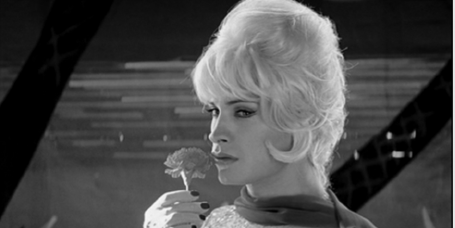
A virtual profile: Zahara (Gael García Bernal) looks like a Hitchcock blonde performing ‘Quizás, quizás, quizás’ in Bad Education.
The actor Gael García Bernal’s performance as Zahara is a conundrum because the sequence is bracketed as Enrique Goded’s fantasy. He imagines the screenplay ‘The Visit’ which Juan/Angel has just given him. In giving Enrique the manuscript, Juan tells him the first part of the story is true, but that he has changed the second half. We may extrapolate then, too, that Ignacio wrote the first half, but Juan/Angel rewrote the second. Hence, the image of the transvestite Zahara, who imitates Sara Montiel on stage, affords an especially complex intersection of interpretations. While Zahara lip-synchs Sara Montiel’s voice on tape singing ‘Quizás, quizás, quizás’ (‘Perhaps, Perhaps, Perhaps’), her costume, especially her blonde French twist wig, recalls not Sarita, who never wore blonde wigs, but Scottie’s double object of desire in Vertigo – Madeleine/Judy. Further, the shots of Zahara’s soignée performance emphasise profiles, which figure prominently in Vertigo. Angel Comas describes the evocation of dualities in Kim Novak’s characterisation in Vertigo:
Novak carries off the character with a combination of carnality and mystery. Her presence borders on magic, especially in the first part, and her eroticism surpasses that inspired by simple physical beauty. In order to differentiate the two stages of the protagonist, Hitchcock used her left profile when she is Madeleine and her right profile when she is Judy. (2002: 33)
Posing mostly in profile, Zahara’s performance is Enrique Goded’s successful projection. It alerts the viewer to his desire to recreate a feminised Ignacio. Critics of Vertigo note that Scottie in fact projects himself in the female doubles he makes over. To recall, Scottie begins the film wearing a corset for his rib injury. He wonders out loud to Midge, ‘Do men wear corsets?’ Recognising, confronting his erotic self, if not his feminisation, causes vertigo. Hence, Enrique will not accept Juan/Angel in the part of Zahara in the remake, not because Angel is a false copy, but because the repetition of Ignacio must be with the significant difference that he, Enrique Goded, is the feminised object of filmic desire, the blonde Madeleine/Judy of Vertigo, as played out in his memory. To recall, Enrique Goded wants to cast Angel as Enrique Serrano in ‘The Visit’. Significantly, Almodóvar gives the spectator a particular reading of Hitchcock’s Vertigo in Bad Education.
Likewise looking at Vertigo may shed light on how to interpret especially enigmatic images of Bad Education, namely the final shots of the pool sequence, a visually complex mating dance. Juan/Angel and Enrique arrive at the latter’s house after a night at clubs. Enrique has just found out that Juan/Angel does not recognise Ignacio’s old favorite Italian pop tune ‘Verita’, hence shedding doubt on whether Angel is merely posing as Ignacio. Enrique dives in the pool naked and tells Juan to follow. He dives over Enrique’s head, but keeps on his briefs. Almodóvar’s script is very specific about the kind of underwear (Ocean) for this sequence. Enrique gets out of the pool and after wrapping himself in a towel sits down on a lounge chair on the deck. Juan/Angel swims underwater over to the side of the pool directly in front of Enrique. In a striking frame the camera shows Juan/Angel holding his breath underwater obscured from Enrique’s view, but with Enrique clearly waiting for him. This moment recalls Scottie’s dive in Vertigo. Fully clothed he dives in to save Madeleine, so he thinks, from committing suicide by drowning under the Golden Gate Bridge. Through the dive he declares his love for her. Madeleine will later be shown naked, or as naked as the 1950s morality code allowed, in Scottie’s bed. In Vertigo Scottie was aroused by her, but she was able to fake suicide, just as Juan/Angel held his breath in the water in Bad Education. Although the sequences in both films have complex implications, each of these erotic, watery sequences function to reveal a stage in the mind game that is the film. Viewing Juan’s underwater breath control in the context of Vertigo’s suicide attempt makes us understand that the stakes of the impersonation game with Enrique have just increased. We can appreciate how the narratives unfold.
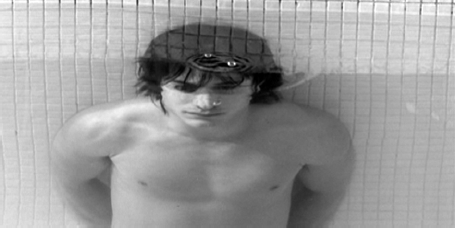
Juan (Gael García Bernal) holds his breath underwater while Enrique waits for him poolside in Bad Education.
One of the most debated aspects of Vertigo is whether revealing to the viewer that Judy and Madeleine are the same person two thirds of the way through the film is effective or not. It is worth recalling that in Vertigo, Judy sits down in her hotel room to write a letter to Scottie, the text of which we hear in voiceover, telling him of her role as Madeleine’s double. Although she tears the letter up, and goes on with her charade with Scottie, the audience knows of the duplicity at that point. In a famous controversy in the Spanish press the director Alejandro Amenábar used this example of an early reveal killing a suspense film when he was interviewed about his thriller Thesis to make light of Hitchcock’s reputation. It is ironic, perhaps intentionally so, that Almodóvar cast Fele Martínez as Enrique in Bad Education, since Martínez launched his career in the role of Chema, the guy who gets the girl at the end of Thesis.25 Almodóvar, however, sides more with Hitchcock than Amenábar in how he constructs suspense and controls information in Bad Education, for the viewer does know early on that Juan is not Ignacio. The only information withheld is that Enrique played along as if he did not know, although he did know all along. For Vertigo, Hitchcock said that the early reveal allowed him to turn the focus to the mental state of Scottie. Likewise, the dominant focus of Bad Education is Enrique’s mind.
Visually, there are other significant allusions to Vertigo, again in some of the most memorable and innovative frames of the film. Perhaps the most striking frames of Bad Education depict the splitting apart of the young Ignacio’s face as if a drop of blood from his forehead severed the image. These frames powerfully represent the consequences of the sexual assault by Father Manolo that Ignacio has just experienced. The motif of tearing is also repeated throughout the credit sequence. Its place in the narrative of the torn face, and how it represents subjective reality, recalls Scottie’s dream sequence of Vertigo after the inquest. Both Vertigo and Bad Education exploit the graphic potential of film to represent a subjective state of victimisation. In Vertigo the headshot comes at a moment in the narrative of Scottie’s maximum victimisation by Gavin Elster (Tom Helmore), and maximum confusion as to his own sanity in accepting his helplessness in Madeleine’s (fake) suicide. Scottie’s head appears in the centre of the frame of pulsating red.
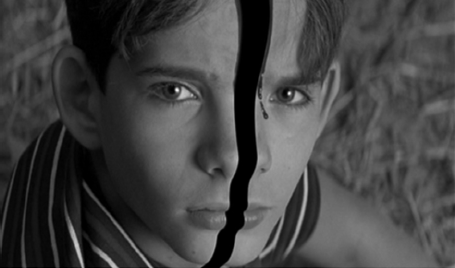
The image of Ignacio’s head, severed by a drop of blood, symbolises the sexual assault he has just experienced in Bad Education.
Some critics have objected to the tonality of Bad Education, and the saturated palette of its mise-en-scène, questioning whether Almodóvar can successfully accomplish a film noir. James Berardinelli writes:
Not exactly Humphrey Bogart. If there’s one genre with which Almodóvar is incompatible, it’s film noir. Known for his vivid, often garish use of colour, Almodóvar is not the kind of director who can work in the murky, desaturated realm that defines film noir. He tries with Bad Education, but the mismatch is apparent. The palette of hues is toned down, but not enough to generate the intense atmosphere that film noir requires. At the same time, the high energy that has defined Almodóvar’s career is muted. (http://www.reelviews.net/php_review_template.php?identifier=1971)
Yet the tonality of Bad Education – the interiors of Enrique Goded’s office decorated in primary colours, for example – recalls a similar intercalation of bright décor in Vertigo, for instance, in all the Midge scenes, both in her kitchen and studio. Although his role is much less important than was Midge’s, Enrique’s reliable helpmate Martín with his tropical shirts is very much her visual and sentimental analog in Bad Education. Hitchcock experimented with a red and green palette in his noir melodrama Vertigo. Nowhere does he create a more successful atmosphere through the use of colour than in the hotel kiss sequence in which the bedroom is bathed in strong green light through the curtain backdrop.
Hitchcock made his most despicable villains sympathetic in some way; Almodóvar has generally followed him in this. However in Bad Education, except for Paca or Ignacio’s mother and aunt, all the male characters – and this is notably a film of male characters – are more darkly threatening than those in his other films. Incredibly, the most understandable, or even humanised, one of them is the despicable child molester, Father Manolo himself. Bad Education is a difficult Almodóvar film, not only because of the topic of child molestation, or gay sex, which together did dampen its popular reception in the US, but because almost none of the characters are attractive in terms of any conventional identification processes. The problem in Bad Education lies with Juan and especially with the uncomfortable fit between the actor Gael García Bernal and his role. There is little playfulness in Juan’s interpretation of Zahara. The low camera angles, for example, emphasise Zahara’s scandalous Sara Montiel/Marilyn Monroe costume, but Juan/Gael’s expressions do not work. The facial and hand expressions are stilted and ill-paced. There is not the voyeuristic pleasure to his performance that the ‘real’ Sara Montiel drag queen communicates later on. Also, Juan/Angel’s face in the throes of gay sex expresses pure pain, not pleasure. The viewer comes to agree with Enrique Goded that Juan cannot play Zahara in the movie. Why? Because Juan is homophobic, and hence wanted to kill his brother. To defend himself as an actor working for a famous director, García Bernal has said that his inner transvestite is Mexican/Caribbean and not Spanish (see Hirschberg 2004). The film plays successfully with these Latin references in the one sequence when Juan, the object of Manolo/Berenguer’s desire, a macho kid in Ignacio’s home, does push-ups with a little waggle of his bum in the air to a Mexican folkloric TV program. This push-up sequence may allude to Plata quemada (Burnt Money, 2000), an important Argentinean movie by Marcelo Piñeyra based on Ricardo Piglia’s novel, which deals with gay sex. By the end of the film, we almost feel sorry for Berenguer being taken in by Ignacio and Juan.
The haunting song ‘Moon River’ which Ignacio sings to Father Manolo’s guitar accompaniment leads one back to I Confess. Both I Confess and Bad Education are disturbing journeys of passion. In Bad Education Father Manolo’s attraction for the young Ignacio is gloriously suggested in the romantic sequence in which Ignacio sings ‘Moon River’. The contrast is stark between the clarity of the young voice and the bright site of playfulness at the river with the priest’s lust for Ignacio. Likewise in I Confess, Quebec City is approached by river on the ferry. In the score this vision is accompanied by a soprano melody. I Confess contains one of the most romantic, if not absolutely saccharine sequences in all of Hitchcock’s works, told from the point of view of a woman. The film flashes back to the romantic tryst, a night of passion on an island, between Father Logan and Ruth Grandfort (Anne Baxter), when she was already married but he not yet a priest. They were discovered in the morning by the property owner Villette (Oliva Légaré), who finds out Ruth was married. The flashback is told from Ruth’s point of view as she tries to exonerate Father Logan from an accusation of murdering Villette, who had been blackmailing her. Father Logan is revealed to be an ordinary man with a human heart, but Father Manolo is revealed to have a darker passion. Murray Pomerance writes of I Confess, ‘Film posits a morality in which vision – and therefore performance – dominates’ (2004: 172).
XV. GOING FORWARD, LOOKING BACK: REVISITED BY VERTIGO AND TRANSFORMED BY ART IN THE SKIN I LIVE IN
Two of Almodóvar’s films post-Bad Education – Volver and Broken Embraces – nostalgically look back to specific earlier films in his career. Volver revisits What Have I Done to Deserve This?, and Broken Embraces, Women on the Verge of a Nervous Breakdown. Francisco A. Zurián perceives a revision of Tie Me Up! Tie Me Down! in The Skin I Live In (2013: 274). Within these retrospective gestures, Almodóvar continues to explore the crime film with narratives that leave the ‘criminals’ exonerated in the view of the audience. Since Hitchcockian allusions tend to occur in an early career stage for most directors, it is not surprising that Hitchcock can be a marginal source of inspiration compared to these films’ manifest self-reflexivity, a trend which Marsha Kinder has consistently explored in her articles in Film Quarterly and in the anthology Almodóvar: el cine como pasión (2005).26 Nonetheless Almodóvar cannot escape Hitchcock’s shadow.
Volver significantly evokes Psycho’s motifs. Almodóvar picks scenes from Psycho that signal an end, as if he wanted to get rid of the master of suspense. When Volver returns to the story of What Have I Done to Deserve This?, to the story of a working-class mother who kills her husband to escape oppression, Raimunda’s (Penelope Cruz) obsessive cleaning up after the murder not only recalls the day job of the working-class mother who kills her husband to escape oppression, but also Norman Bates’ (Anthony Perkins) thoroughgoing bathroom duty after killing Marion (Janet Leigh). Likewise, when Raimunda watches the sinking of the freezer, which contains her husband’s body, in the river, she stands metaphorically in the place of Norman Bates watching the sinking of the car with Marion’s body in the trunk in Psycho’s swamp.
Through camera placement, Almodóvar weaves an intertextual history and pays off his debts. In a section of the author’s commentary to The Skin I Live In’s script, titled ‘Los invitados imprevistos’ (‘The Unexpected Guests’), Almodóvar says the film’s opening shot was in homage to Buñuel’s Tristana (1970):
Even Buñuel has his own citation, in the first image of the movie. It’s an overview of the city of Toledo, which establishes the time and space of the narration. El Cigarral is located 4 kilometres from Toledo. To introduce the city I specified placing the camera in the same location that Buñuel had placed it in Tristana to give a general shot of the city. I tried to repeat that shot in homage to the master. (2012: 160)
Before crediting Buñuel, he emphasises his consistent, profound obsession with Hitchcock: ‘Throughout the later stages of production unexpected guests have kept appearing, clear resonances related to the literature and films of the fantastic. It’s impossible not to think of James Whale’s Frankenstein, or Alfred Hitchcock’s Vertigo and Rebecca’ (ibid.). He returns to Vertigo later in his comments, where he sees the figure of the director imprinted:
And, with respect to the master of suspense, it’s very difficult to get away from the influence of Hitchcock, and specifically, of Vertigo. In Broken Embraces when the director Mateo Blanco directs Lena by whispering into her ear in the hair and make-up tests, he’s creating a new woman for his own pleasure. For her to escape from her calamitous life and take refuge in a new woman, he proposes the role of Pina to her. Vertigo was already there – when James Stewart takes charge of the styling, the hair colour, the hairstyle, the clothes of Kim Novak, until he transforms her into the dead woman he loved so much. When I see Stewart rejecting suits in the dress salon, and the clerk telling him, ‘I see the gentleman knows exactly what he wants,’ I see myself with the actresses deciding and trying on the dresses that will help them become the ‘other woman’ for me. James Stewart represents the figure of the director. (2012: 160–1)
Although Almodóvar is speaking about Broken Embraces, the presence of Vertigo, and its obsessive transformations, is even stronger in the romantic thriller, The Skin I Live In, whose primary sources were George Franju’s horror film, Les yeux sans visage (Eyes Without a Face, 1959), and Thierry Jonquet’s best selling novel, Mygale (1984).27
The Man Knows What He Wants: Scottie (James Stewart) selects clothes to dress Judy/Madeleine (Kim Novak) at Ramshoff’s Department Store in Vertigo.
Through his experiments with artificial skin, Dr. Robert Ledgard (Antonio Banderas) transforms Vicente (Elena Anaya) into Vera, in the image of his wife Gal. Almodóvar writes, ‘Over Vicente’s face [Dr. Ledgard] has sculpted the face of his dead wife Gal (the distorted myth of Vértigo appears again)’ (2012: 162). Gal had committed suicide by throwing herself out a window because her body, which had been burned in a fire, was so deformed she could not stand to see herself in a mirror. Both films, which are structured around doubling, have a pair of tragic falls from heights. In Vertigo Scottie sees the body of Madeleine, wife of Gavin Elster, thrown out of the window of the mission tower. Because Scottie can’t intervene or insert control over this accident scene, since he can’t overcome his vertigo to climb the tower, he stays trapped in his amorous obsession and search for the tragic Madeleine. Vertigo ends by repeating the mission scene when Judy falls to her death from the tower. Likewise in The Skin I Live In Norma, Gal and Robert Ledgard’s daughter, repeats her mother’s suicide when she throws herself out of the window. Norma can’t overcome her psychological distress brought to a crisis state because of a rape.
Significantly The Skin I Live In reinterprets Vertigo’s obsessions and transformations through a feminist or LGBT critique of gender politics. Although in Vertigo Judy reluctantly allows herself to be transformed into Madeleine, in The Skin I Live In Dr. Ledgard transforms Vicente into Vera under great duress and control. At times Vera endures her captivity as a case of Stockholm syndrome. She eventually rebels and frees herself from Roberto by killing him. Before she shoots him, she tells him she had lied when she promised him she loved him. As we have already noted, works of art, respectively Carlotta’s portrait, and Titian’s Venus, mediate the males’ obsessions in Vertigo and The Skin I Live In. The transgender perspective in the form of the film’s critique of Vertigo, through which Vera becomes the active agent of her destiny, is also accomplished through the visual arts.
Although Vera has been transformed by Dr. Ledgard from a man, Vicente, into a woman, Vera, this bodily change does not affect his/her core identity. In the film Vera becomes fascinated by a TV program on Bourgeois’ work, ‘the sculptures with two sexes, the sackcloth heads, and the multiple dolls, some of which made with the cloth from the artist’s own underwear’ (Almodóvar 2012: 168). Vera consoles herself in captivity by contemplating and recreating Bourgeois’ art. As Holland Cotter observed in the Bourgeois obituary in the New York Times, her sculptures, ‘from first to last shared a set of repeated themes centered on the human body and its need for nurture and protection in a frightening world’ (2010). Vera fashions small clay sculptures and copies onto the wall drawings and phrases such as, ‘Art is a symptom of health’. Almodóvar elaborates on her transformative activities: ‘She also “dresses” some of the balls she uses to practice yoga with various pieces of cloth, from different items of clothing, all of this inspired by Louise Bourgeois and her own skin’ (2012: 168). He notes that this takes her back to when, as Vicente, he made and dressed scarecrows for the windows of his mother’s boutique. Besides appreciating the specific images that Vera peruses and remakes in the film as an art cure, for spectators of the film the mere inclusion of Bourgeois’ work may have additional symbolic force that applies to a wider global discourse around gender. Bourgeois was known for her vocal defence of LGBT rights, and especially the freedom to marry, a cause she supported through the mass-market sale of prints of her work ‘I Do’. She was also known for vertical twisting spiral sculptures, often staircases, such as those displayed in her 2000 Tate Modern installation, ‘I Do, I Undo, I Redo’. The closing credit sequence to The Skin I Live In of abstract helices may be read as a combined homage to Bourgeois’ art and Hitchcock and Saul Bass’s spiral images that open Vertigo.
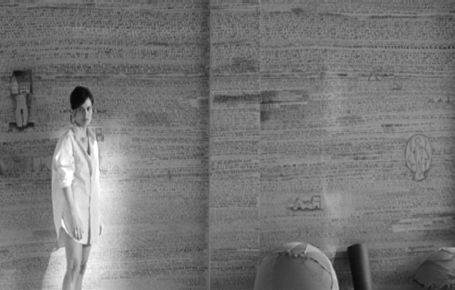
Art inspired by Louise Bourgeois: Vera (Elena Anaya) in the midst of her drawings and ‘dressed’ yoga balls in The Skin I Live In.
Vicente six years earlier dressing mannequins/scarecrows for his mother’s boutique in The Skin I Live In.
The final credit sequence of a helix in The Skin I Live In.
The obsession to transform the other through the selection of clothing, in which Almodóvar sees his role as a director, figures prominently in the aesthetics and narrative arc of The Skin I Live In. In the middle of the film, in the section ‘Six years earlier’, which deals principally with Norma’s (Blanca Suárez) rape, we meet Vicente dressing a mannequin of a woman’s clothing boutique, which is owned by his mother. Later Vicente tries to convince the clerk Cristina (Bárbara Lennie) to accept a gift of a flowered dress. Cristina, a lesbian, refuses the gift. The mere idea of trying it on and the sexual advances implicit in the gift upsets her. When after having killed Dr. Ledgard and his mother Marilia, Vera comes back to Vicente/Vera’s own mother’s store, and reconnects in a loving gaze with Cristina, it is precisely this earlier private conversation over the flowered dress that serves as the proof that reveals and confirms Vicente’s submerged and unalterable identity. Almodóvar declares that The Skin I Live In is fundamentally a movie about identity: ‘Although Vera has changed her skin, she hasn’t lost her identity’ (2011: 154). He even offers a synopsis of the movie via the dress:
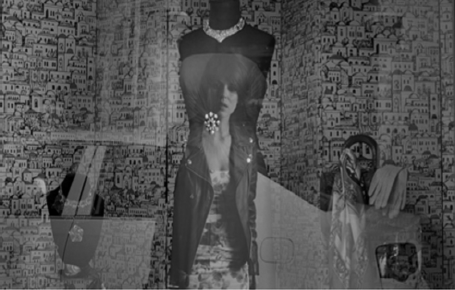
Vera/Vicente returns to her/his mother’s boutique to prove her/his identity by wearing the Dolce & Gabbana dress in The Skin I Live In.
It is the story of a very body-hugging, round-necked dress. The fabric is a print of light-coloured flowers, designed by Dolce & Gabbana. One day Vicente offers the dress to Cristina as a gift. He’d like to see how it fits her. Cristina turns him down. Vicente insists, emphasizing the item’s details. Cristina answers, ‘If you like it so much, you put it on.’ Vicente disappears under strange circumstances and returns six years later to the same place in the store where he offered her the Dolce & Gabbana dress. But now he has it on, as a sign of identity so that Cristina will believe all he has to tell her. The Skin I Live In tells the unimaginable trials that Vicente has to suffer until he manages to return to his mother’s boutique, wearing the Dolce & Gabbana dress on the body that has been imposed on him. (2011: 164–5)
While in Hitchcockian terms the dress is the picture’s MacGuffin, it is also the motif through which Almodóvar asserts his role as a director. By naming the main character Vera, and representing her as a survivor of sexual torture, he not only calls attention to but also metaphorically ‘redresses’ the wrong done to Vera Miles. Hitchcock’s treatment of Vera Miles, forbidding her to get pregnant because he wanted her to play Kim Novak’s part in Vertigo, was an act that Almodóvar said he could not forgive (Strauss 2006: 144). Almodóvar’s reinterpretation of Vertigo allows him to assert his own voice in contemporary gender politics.28
XVI. CONCLUSIONS: ECLIPSING BUÑUEL
In this chapter we have explored specific allusions to Hitchcock throughout Almodóvar’s career. Indeed the depth and breadth of these instances, or ‘robberies’, lets us speak, in most conventional terms, of a strong, recurring influence. At other moments, in the case of Dark Habits, Hitchcock’s career model, as well as his aesthetics in Stage Fright, served as a template and afforded an original perspective on the connections between them. How Almodóvar interpreted Hitchcock to build his career in his early stages has been perhaps the least explored, and at times the least acknowledged connection of all.29
What we have seen in these specific cases has been most often the serious side of the two directors’ work. Exact parallels in terms of their sense of humour, the repetition of the same jokes, visual or verbal, are more difficult to construct, but no less important to underscore since it is in the continued presence of humour in crime narratives or suspense that Spanish or Latin Hitchcockian adaptations differ from their French or American counterparts.
Both directors have a fine appreciation of ensemble work. Their minor characters are genuinely memorable. Take Chus Lampreave, in almost any film, but for example as the mother-in-law in What Have I Done to Deserve This?; and compare her to Marion Lorne as Mrs. Anthony in Strangers on a Train. Both mothers are funny through different ways in their absurdities. Or consider the group social dynamics of the working class: compare the pair of girdle salesmen Richard Hannay encounters on the train in The Thirty-Nine Steps to the nurses on their lunch break in Talk to Her. How these workers interact is blunt and tone perfect in plausible dialogue, and yet incredibly funny as well. Both directors appreciate, and are finetuned to the place of, the domestic in creating identifiable comic effects, and in thereby really connecting with the audience. In Murder! the landlady chatters away with witnesses, while the crime scene is being examined right in her living room, about how to make a perfect cup of tea. Hitchcock uses this recipe to maximum humourous effect in Frenzy. The cheerful wife of Inspector Oxford (Vivien Marchant) lovingly recites her nouvelle recipes for ‘soupe de poisson’, quail and pig’s foot, fancy meals which he tries to avoid eating and which make him long for meat and potatoes. All the while she intuitively dissects the case, cracking it literally as she does her breadstick, and points the inspector toward the real killer. McGilligan considers these scenes ‘a transparent riff on Mr. and Mrs. Hitchcock’ (2003: 702), who worked out their plots over mealtimes. During the filming of Frenzy Alma Hitchcock suffered a serious stroke, which preoccupied Hitchcock but only caused him to press on. Hence, the food interludes in Frenzy can also be considered an embedded love letter in the film, a motivation not unlike Pepa’s in Women on the Verge of a Nervous Breakdown. Alma reportedly ‘wept uncontrollably with pride’ (McGilligan 2003: 712) when she finally saw Frenzy for the first time.
In Frenzy the food motif builds through many phases and even takes a Latin turn. The underling policeman is subjected to his boss’s wife’s too exotic and overly sour margarita, whose recipe she has carefully recited to him, as she always does to her husband. This final Latin twist to the joke may have been particularly suggestive to Almodóvar. A similar, domestic, extended joke is a crucial component of Women on the Verge of a Nervous Breakdown. Pepa (Carmen Maura) describes her recipe for gazpacho – which symbolises her love for Ivan (Fernando Guillén) – slowly and with maximum effect to the detectives, while she is waiting for the sleeping pills she has doped the mix with to kick in. Significantly, in Frenzy the wrong man Richard Blaney (Jon Finch) escapes from the prison hospital by getting the other patients to pool their sleeping pills. They drug the guard by putting their cache in his coffee. Even without delineating precise influences, we can say that Almodóvar’s work shows a sense of humour not unlike Hitchcock’s. The parallels, however, allow us to see how both Hitchcock, in his mocking of French cuisine and the Brits’ preferences for stodgy cooking, and Almodóvar, in his ode to the Mediterranean gazpacho, play off national or local preferences for global effects.
It is significant that Frenzy marked Hitchcock’s return to the UK, his first movie filmed outside of Hollywood in twenty years. Widely thought, erroneously, to be making his last film at the time, he was looking to recapture positive critical attention after Marnie and Topaz and match his earlier box office success. The movie begins acknowledging the shift in locale with postcard-style shots of London in a helicopter-ride view of the Thames and the Tower Bridge. In Women on the Verge of a Nervous Breakdown, whose very title recalls Frenzy in that it signifies the effects of the modern frenetic pace of life, Carlos (Antonio Banderas), Iván’s son, holds up the postcards of Madrid’s landmarks, the Cibeles fountain and the Puerta de Alcalá, written from his father to Pepa, which he discovers in Pepa’s bedroom. Not only is Hitchcock a model for a good joke in the recipe recitations, but also how Hitchcock uses national references through broad, ironic tourism is likewise a pattern for true entertainment and resucitated box office success. Almodóvar appreciated, and exploited both. The audience can share the nostalgia trip.
At the 2010 Cannes Film Festival Almodóvar gave a speech to introduce the film Tristana at a tribute to Buñuel. He began half tongue in cheek: ‘I don’t believe Buñuel would have found it amusing that I’m the one doing the presentation of Tristana. But since he’s dead, I’ll dare do it’ (ABC, 16 May 2010: 69). Instead of introducing the film he proceeded to give what El Mundo called ‘a homage from Pedro Almodóvar to Pedro Almodóvar’, in which he spoke proudly, and at length, of the reputation he has acquired in France, his ‘first market’, and implied that his status now eclipsed Buñuel’s (15 May 2010). The organisers, and Tristana’s star, Catherine Denueve who was present, were not pleased. Indeed as Almodóvar anticipated, Buñuel probably would not have taken the insult well either, yet an abbreviated version of the El Mundo headline is accurate – ‘Almodóvar eclipsa a Buñuel’ (‘Almodóvar Eclipses Buñuel’) (ibid.). Almodóvar may have shown poor manners, but for today’s moviegoers, and from the point of view of world film criticism, if Spanish cinema is reduced to one name, it is Almodóvar and no longer Buñuel. His attention to Hitchcock, which at times, as in Live Flesh, has been mediated by allusions to Buñuel’s work, has been a major factor in this generational shift away from Buñuel that has brought Almodóvar acclaim as the most important Spanish director of our times.
The presence of Hitchcock’s films in Almodóvar’s work spans both the breadth of Hitchcock’s output, with notable emphasis on his British period in black and white as well as his later masterpieces for which he tends to be best known, and the breadth of Almodóvar’s ouevre, from Labryinth of Passion to The Skin I Live In. Even if he has long ago ceased to be anyone’s apprentice, his mature relationship to Hitchcock finds him mining the depths of the masterwork Vertigo in both Bad Education and The Skin I Live In. The intuitive modes of conduct that shaped his early films have now become both authorial strokes. While aspects associated with the creation of ‘suspense’ do not go unnoticed, as we have seen, his films show a far deeper appreciation of Hitchcock’s cinematography and construction of narrative. Our comparative exploration has shed light furthermore on intriguing interplays in their sense of humour, representations of religion and gender, and interest in art and theatre.
